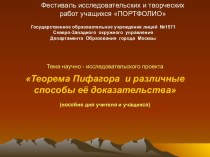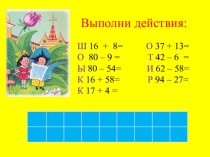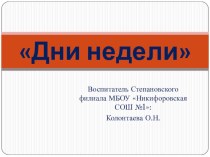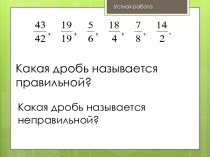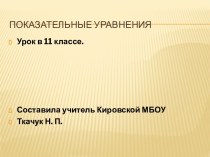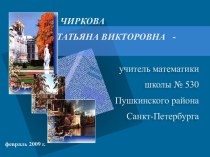- Главная
- Разное
- Бизнес и предпринимательство
- Образование
- Развлечения
- Государство
- Спорт
- Графика
- Культурология
- Еда и кулинария
- Лингвистика
- Религиоведение
- Черчение
- Физкультура
- ИЗО
- Психология
- Социология
- Английский язык
- Астрономия
- Алгебра
- Биология
- География
- Геометрия
- Детские презентации
- Информатика
- История
- Литература
- Маркетинг
- Математика
- Медицина
- Менеджмент
- Музыка
- МХК
- Немецкий язык
- ОБЖ
- Обществознание
- Окружающий мир
- Педагогика
- Русский язык
- Технология
- Физика
- Философия
- Химия
- Шаблоны, картинки для презентаций
- Экология
- Экономика
- Юриспруденция
Что такое findslide.org?
FindSlide.org - это сайт презентаций, докладов, шаблонов в формате PowerPoint.
Обратная связь
Email: Нажмите что бы посмотреть
Презентация на тему по сопромату3
Содержание
- 3. Bob Gilliver MSC/ARIES European Product Marketing and Support Manager
- 4. GeometryFE AnalysisOptimizationMechanismsPlasticsMSC/ARIES Positioning
- 5. GeometryFull function ACIS based modelerConstraintsfull partial noneACIS data exchangeAutoCADBentleyIntegraphHP
- 6. GeometryModify dimensions
- 7. GeometryModification by dimensionParametric relationships
- 8. GeometryComplex solidsSkin operatorSweep operatorExtensive blending and chamferingRegion operator to sub-divide geometryMap meshingLoad footprint areasSymmetry
- 9. MSC/ARIES Base - AssembliesVisualizationPackagingClearance InterferenceMass properties
- 10. MSC/ARIES Base - Mass Properties
- 11. Geometry - Regioning
- 12. Geometry - Regioning
- 13. Geometry - Regioning
- 14. Geometry - Regioning
- 15. Pre Release Solids ShellingShelling of solids to
- 16. Analysis Of ACIS &Imported GeometryCADARIES
- 17. Geometry Interface - ACISSupport for ACIS sat
- 18. Geometry Interface - Autocad Import
- 19. Geometry Interface - Autocad Import
- 20. Geometry Interface - Autocad ImportLin. Static Error Contours
- 21. Geometry Interface - Autocad Export
- 22. Geometry Interface - IGES ImportSupportsWireframe Point, line,
- 23. Geometry Interface - IGES ExportSupportsWireframe Point, line,
- 24. Geometry Interface - DXF ImportWireframePoint, line, arc, polylineText
- 25. Geometry Interface - DXF ExportSupportsWireframe Point, line,
- 26. Geometry Interfaces - STEP, VDAFSPDES/STEP AP203Import and
- 27. Geometry Interfaces -StereolithographyTranslates solids into standard “stl” formatRapid manufacture for physical part prototyping
- 28. GeometryFE AnalysisOptimizationMechanismsPlasticsMSC/ARIES Positioning
- 29. LBC’s applied to geometry or to nodes
- 30. Constant or functional varying magnitude Geometry based
- 31. Load and Boundary ConditionsDirection control for load/boundary conditionsXYZRadialTangential
- 32. Load and Boundary ConditionsLoad case combination (5 * load_1) + (3 * load_2)
- 33. Automeshing technologyEdges -- 1D elements (beam, gap, rigid, spring)Surfaces -- quad
- 34. Auto MeshingSolid Element Automesh
- 35. FE MeshingAdaptive mesh refinementAutomatic mesh refinement to
- 36. Original mesh -
- 37. FE MeshingDirect creation of nodes/elementsExtrude/revolve 1D to
- 38. Display optionsVectorContourGraphAnimationCutting planeResults in any coordinate systemData averaging controlResults combinationError calculationResults Review
- 39. Linear StaticsLoads constant with timeMaterial assumed linear and perfectly elasticResults calculatedStressDisplacementStrainStrain energyReaction force
- 40. Normal ModesCalculates undamped natural modes of vibrationMaterial assumed linear and perfectly elasticResults calculated (normalized)StressDisplacementStrainStrain energyReaction force
- 41. Linear BucklingCalculates load factor for critical bucklingMaterial assumed linear and perfectly elasticResults calculatedStressDisplacementStrainStrain energyReaction force
- 42. Non-Linear StaticsGeometric non-linearityChange in stiffness associated with
- 43. Non-Linear StaticsNon-linear Elastic Material
- 44. Structures-2 Non-Linear Statics Load FollowingDeformed - load followingDeformed - load followingFFFUndeformed
- 45. Linear Transient DynamicsTime varying geometry and finite
- 46. Heat TransferSteady state and transient linear and
- 47. Heat Transfer
- 48. MSC/ARIES To MSC/PATRANARIES Created Geometry
- 49. MSC/ARIES To MSC/PATRANImported ARIES Geometry in MSC/PATRAN
- 50. GeometryFE AnalysisOptimizationMechanismsPlasticsMSC/ARIES Positioning
- 51. OptimizationAn Automated Process That:Satisfies Your Design Objective Within Design Constraint(s) By Modifying Design Variables
- 52. Optimization - Overview1 Design Objective minimize/maximize weight,
- 53. Optimization - OverviewShape Geometry dimensions as design
- 54. Initial Design
- 61. Final Design
- 62. Optimization - ApplicationBuild solid or surface geometryAssociate
- 63. Optimization - ApplicationCreate finite element modelSelect Optimization
- 64. R1L2L1R3R2DEP INDEPR1
- 65. Optimization - Results ReviewPost process in Optimization
- 67. P-Elements - OverviewAutomatically increases element’s shape function
- 68. P-Elements - OverviewEach edge of each element has its p-order independently controlled in MSC/NASTRAN552314
- 69. P-Elements - ApplicationSupported element typesTetrahedronBrickPentahedron (wedge)p-order min/max
- 70. P-Elements - ApplicationConstrains shared edges to
- 71. P-Elements - ApplicationHex to tet mesh connection
- 72. P-Elements - Results Reviewp-element results review identical to h-elementsCan display final p element order contours
- 73. GeometryFE AnalysisOptimizationMechanismsPlasticsMSC/ARIES Positioning
- 74. Two- and three-dimensional mechanism modeling analysis and
- 75. Create link geometryGeometry can be solid, surface
- 76. Mechanisms Results ReviewAnimated motion of linksMotion path
- 77. GeometryFE AnalysisOptimizationMechanismsPlasticsMSC/ARIES Positioning
- 78. Plastics3D mold fill analysisUses Moldflow/Flowcheck solverSolves “Will
- 79. PlasticsMSC/ARIES Created Solid
- 80. PlasticsMold Fill Time Contours
- 82. Modular Configuration
- 83. Modular Configuration
- 84. MSC/ARIES Base
- 85. Optional Modules
- 86. Platform Support WindowsNTSun SolarisSGIHPIBMDigital Unix
- 87. Intel based (not Digital NT)Recommend >= Pentium
- 88. Supported Unix workstation32Mb RAM125 Mb swap spaceLicensingNode-lock, andFloating network licensePlatform Requirements - Unix
- 89. GeometryFE AnalysisOptimizationMechanismsPlasticsMSC/ARIES Positioning
- 90. MSC/ARIES PositioningStandalone Design and Analysis SystemDesigned and
- 91. StructuralThermalMechanismsPlastic Molding AnalysisMSC/ARIES Positioning
- 92. MSC/ARIES The Flow of DevelopmentProductAlmost all design concepts will be decided
- 93. Positioning of MSC/ARIESFEA AnalystDesign EngineerLow priceHigh priceStatic-Eigenvalues-Optimization-Heat-Dynamic-Nonlinear-Electromagnetic-Crash-NVHEasy
- 94. Positioning of MSC/ARIESEndStartManufacturing ProcessManufacturingBill of MaterialsMaterial DatabaseDraftingAnalysisOptimizationModelingDesignMSC/ARIESPredictive EngineeringCAD linkedCAD SystemModification Costs
- 95. Positioning of MSC/ARIESMSC/ARIESTargeted UserNon-FE SpecialistGeometry Based AnalysisConceptual
- 96. Positioning of MSC/ARIESGuide line thought / Question ProcessCAD SystemImport GeometryCreateGeometryFEAwareN4WARIESPoss.No SaleConflict WithExistingModellerNeed ToCreateDrawingsACIS DraftingPackage (AutoCAD etc)NOYes
- 97. THE END
- 98. Mentor BoardStation InterfaceBi-directional interface using Mentor IDF
- 99. Скачать презентацию
- 100. Похожие презентации
Bob Gilliver MSC/ARIES European Product Marketing and Support Manager
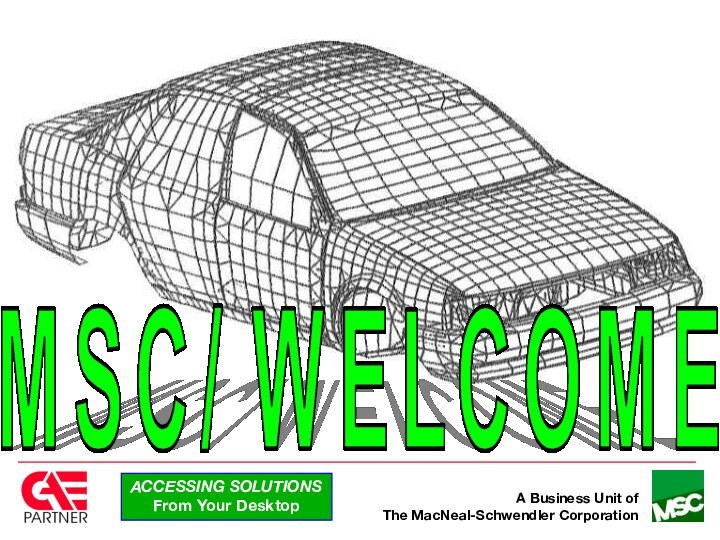

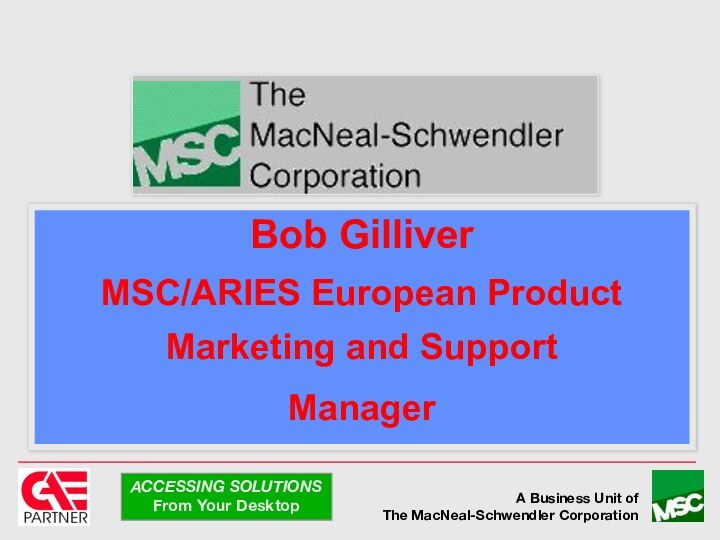
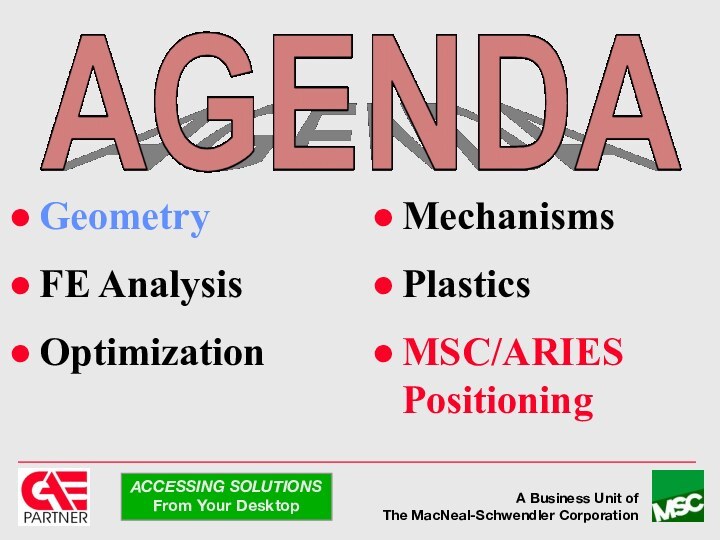
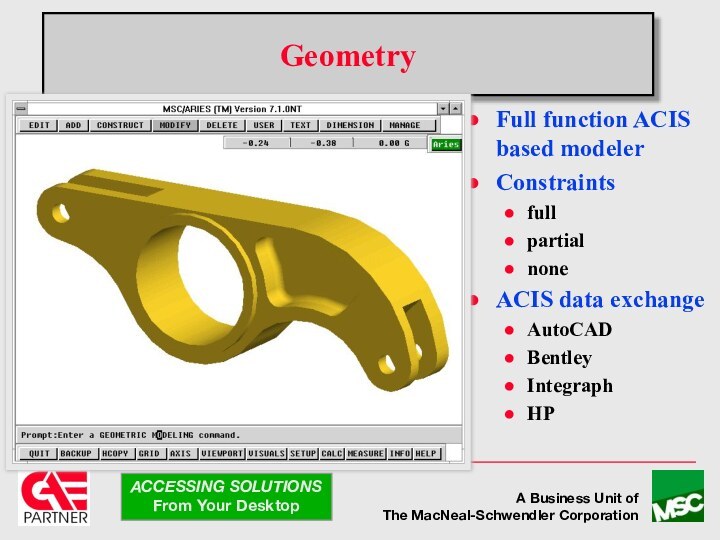
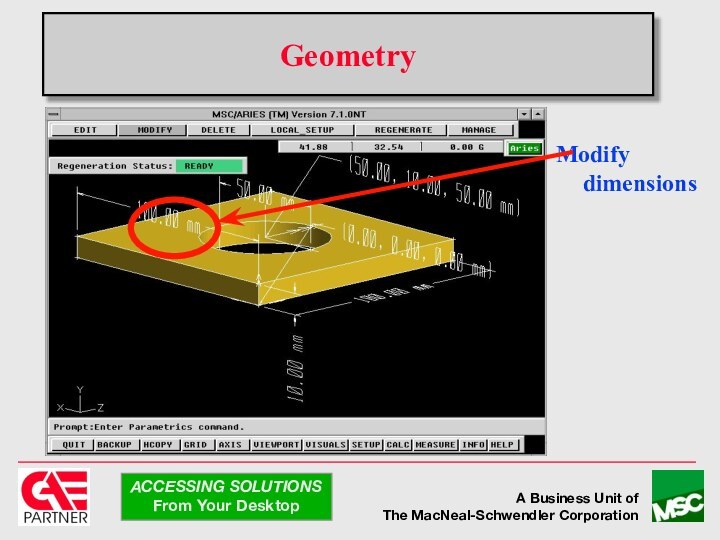

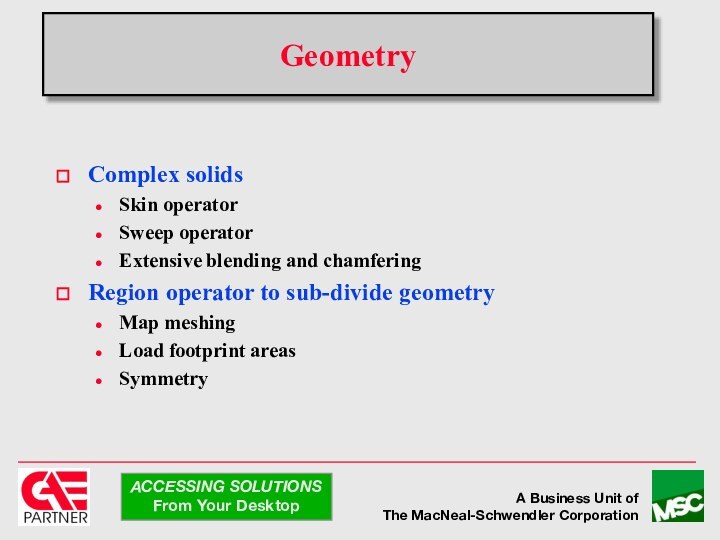
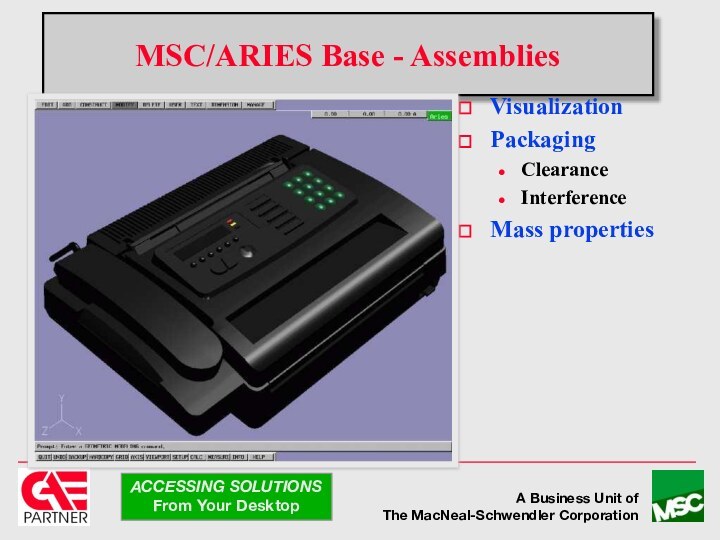

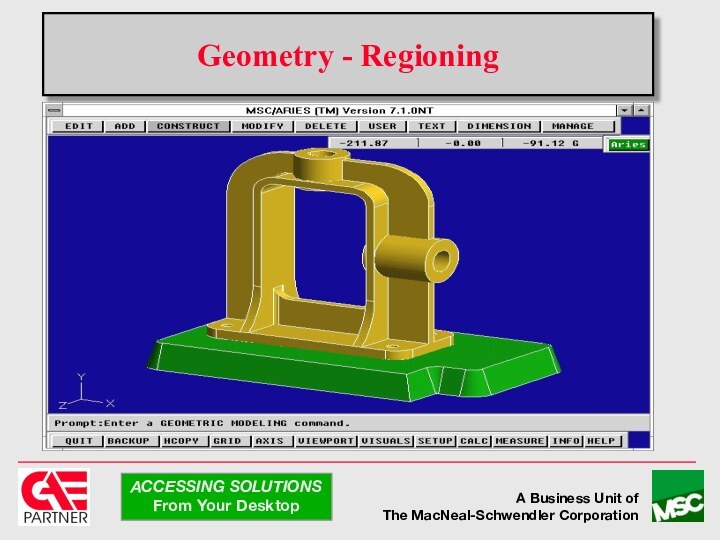
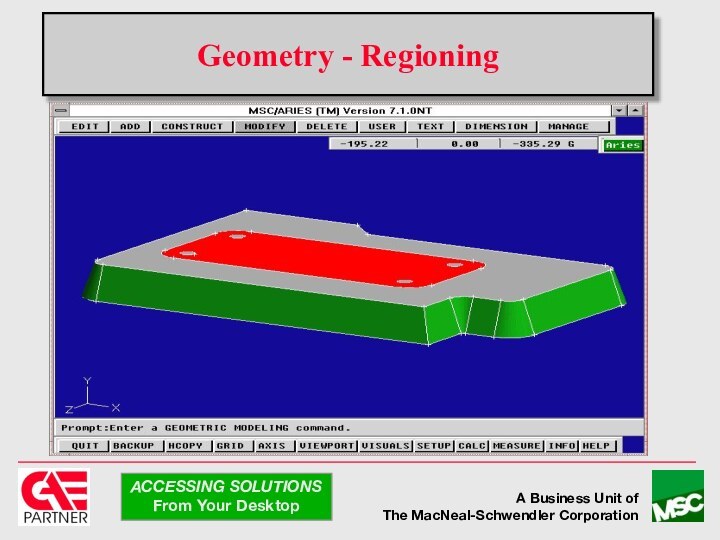
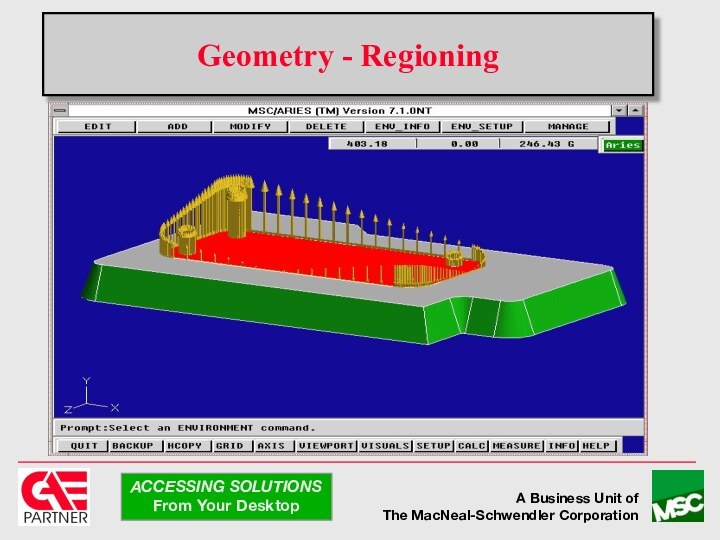
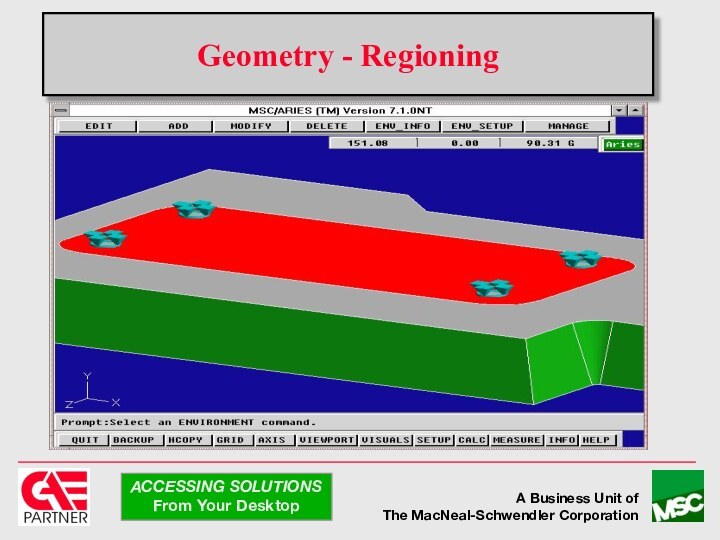

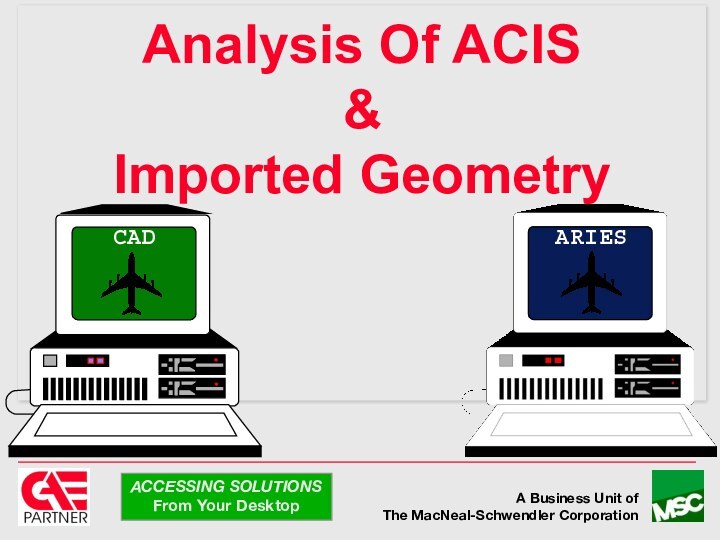
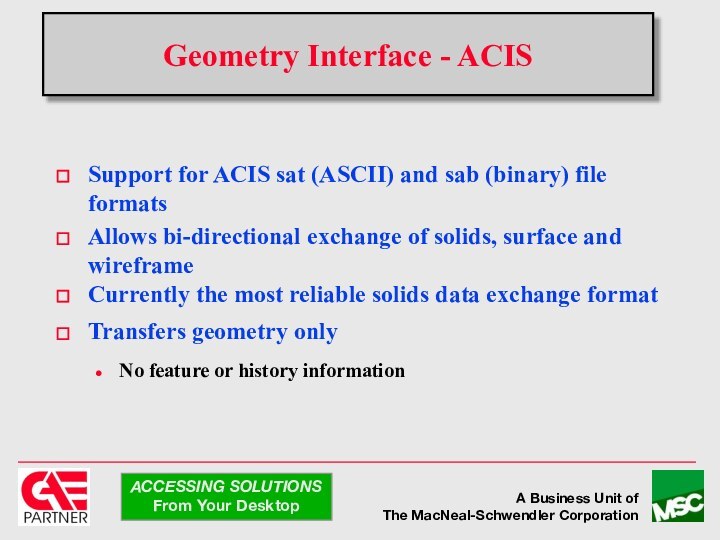
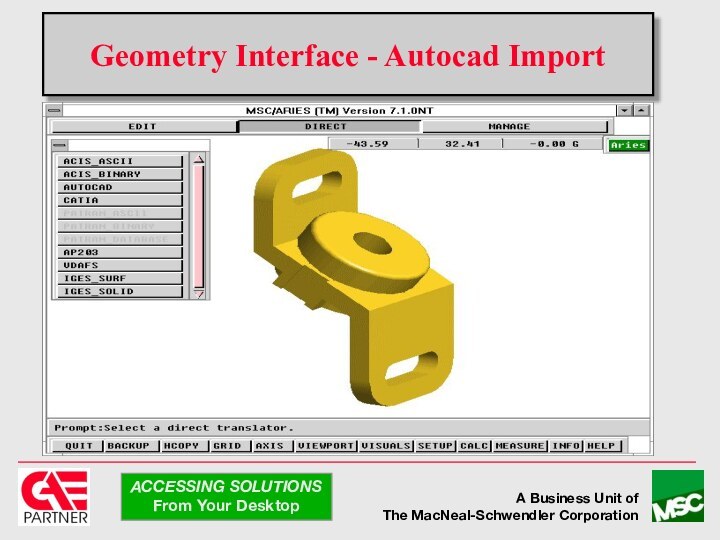
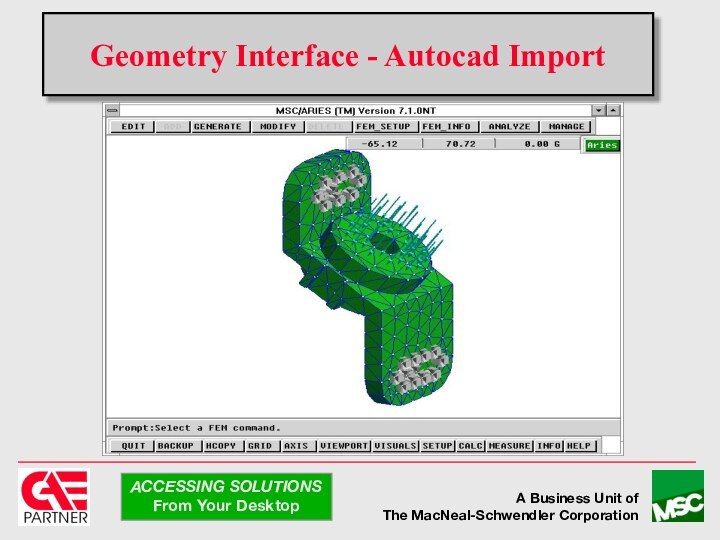

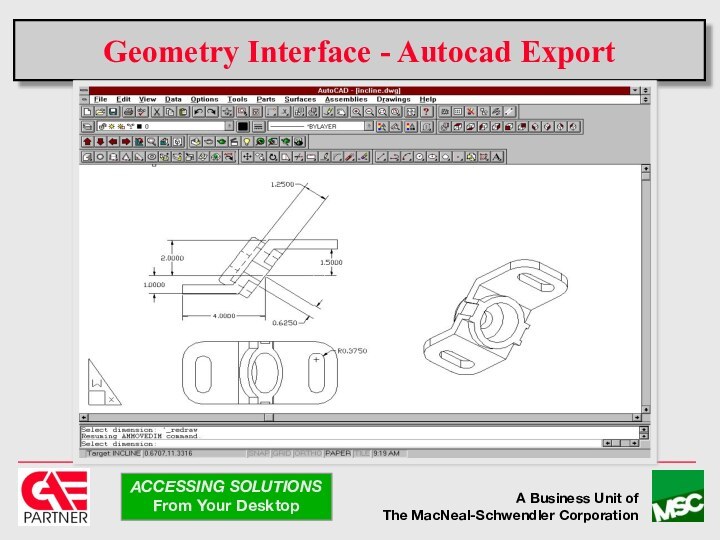
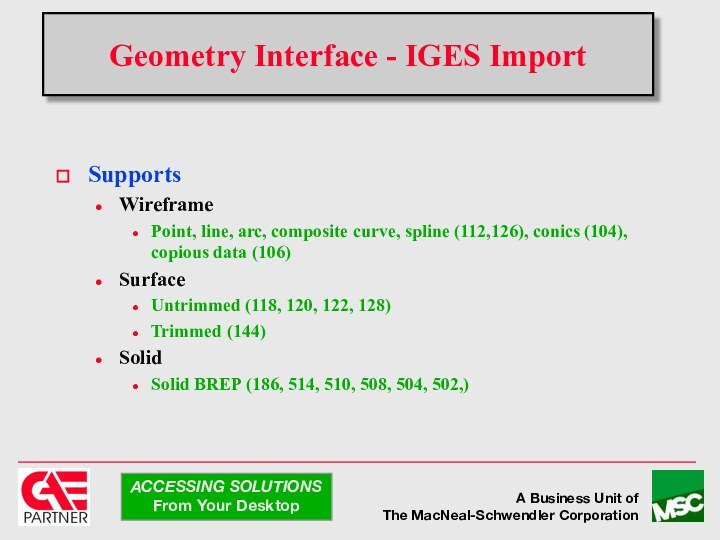
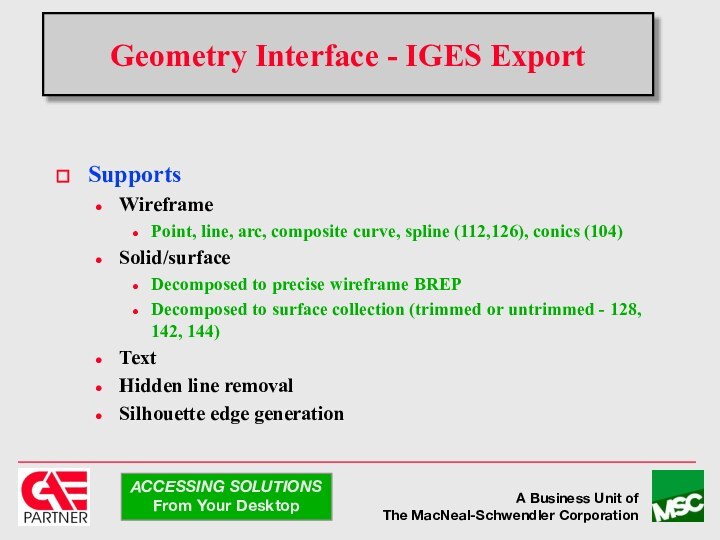
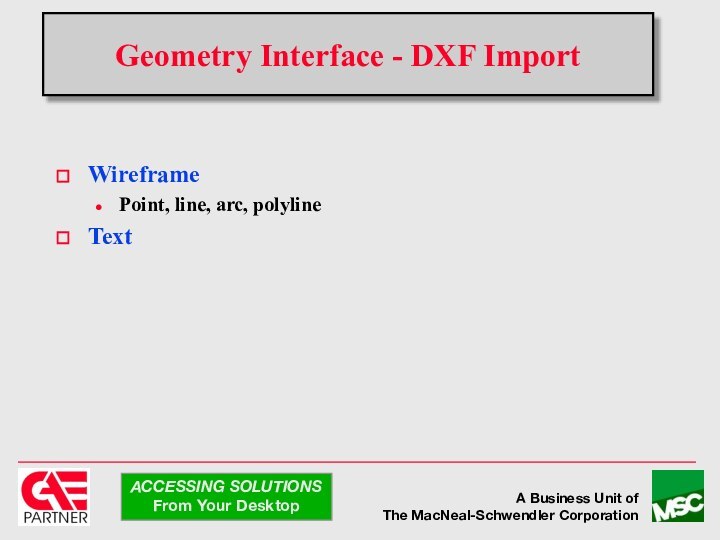

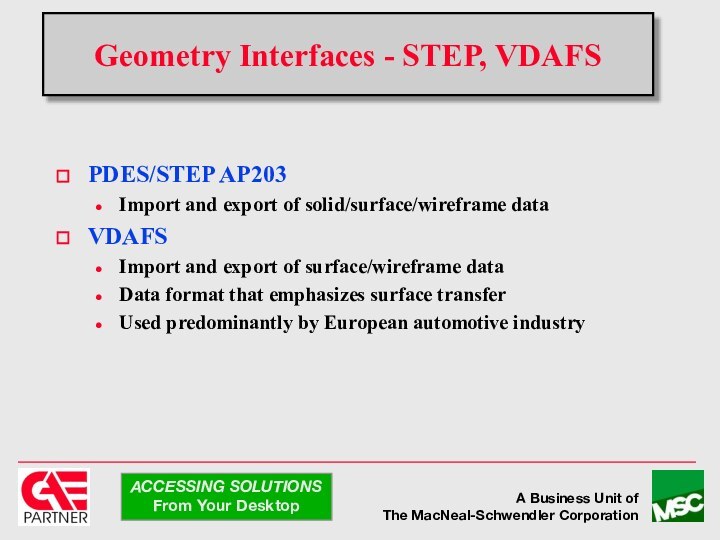
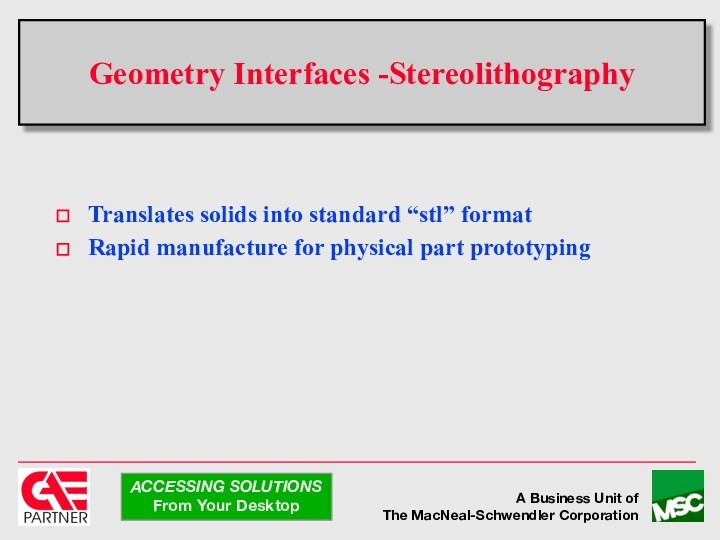
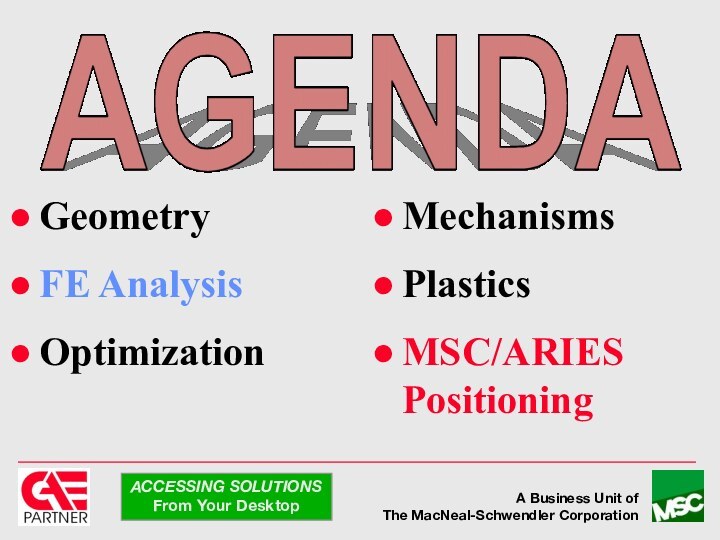

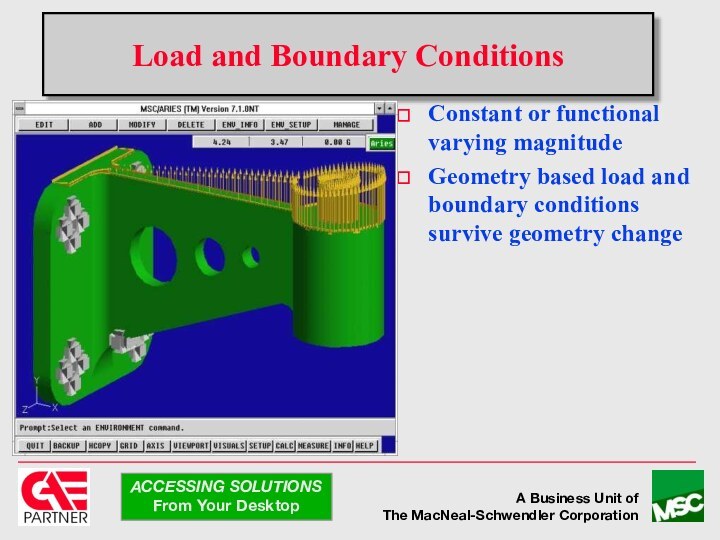
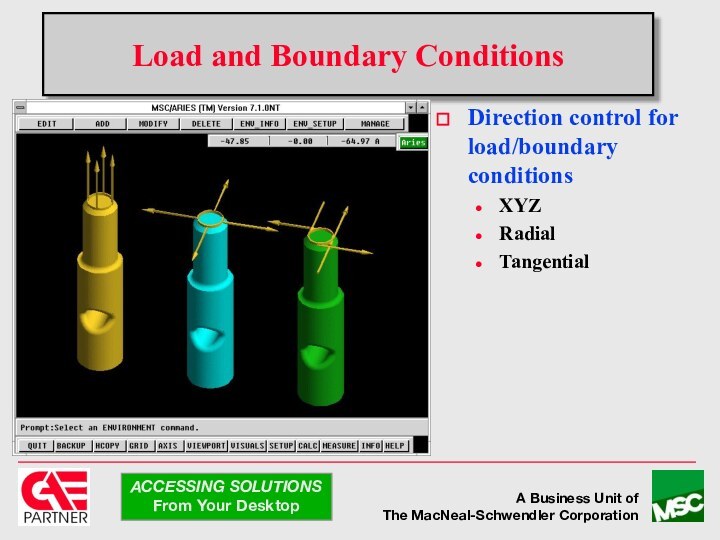
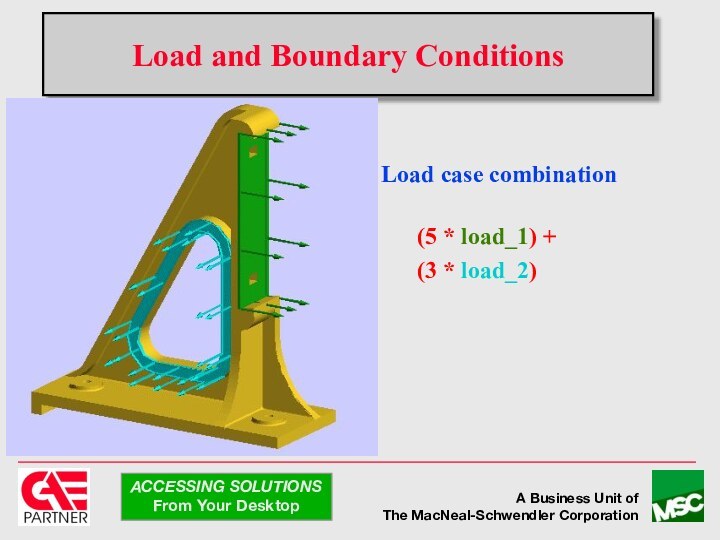
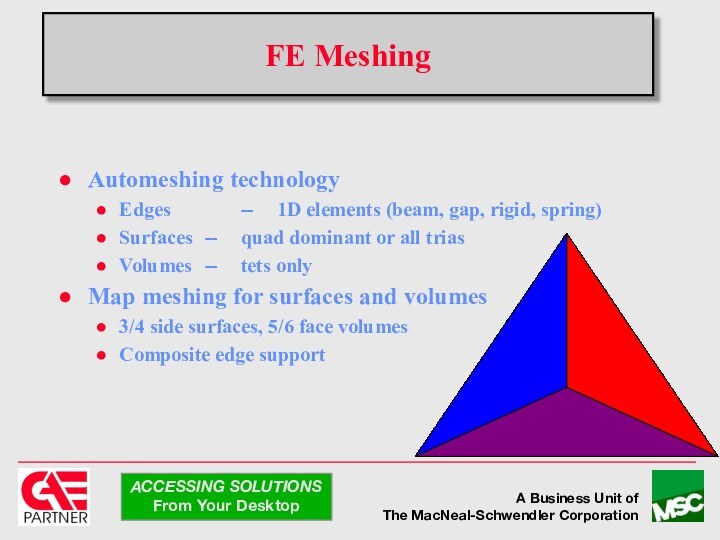
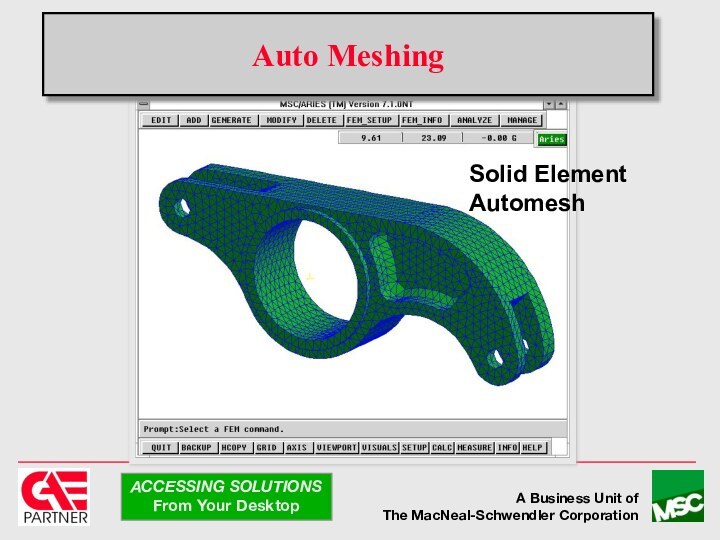
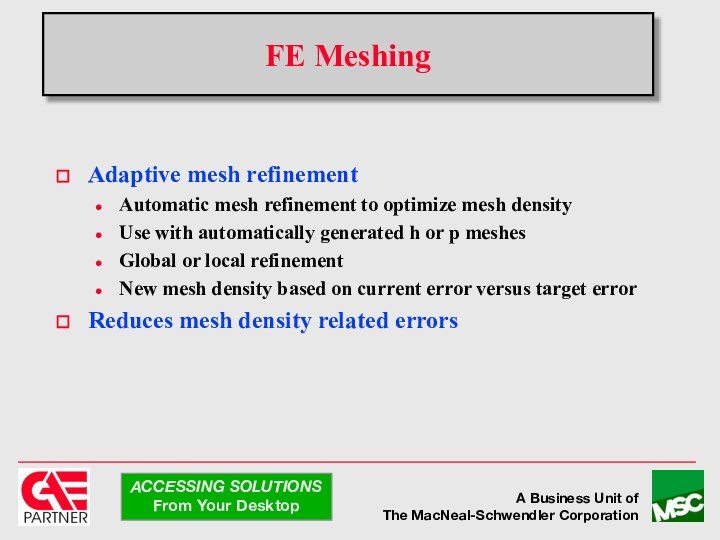

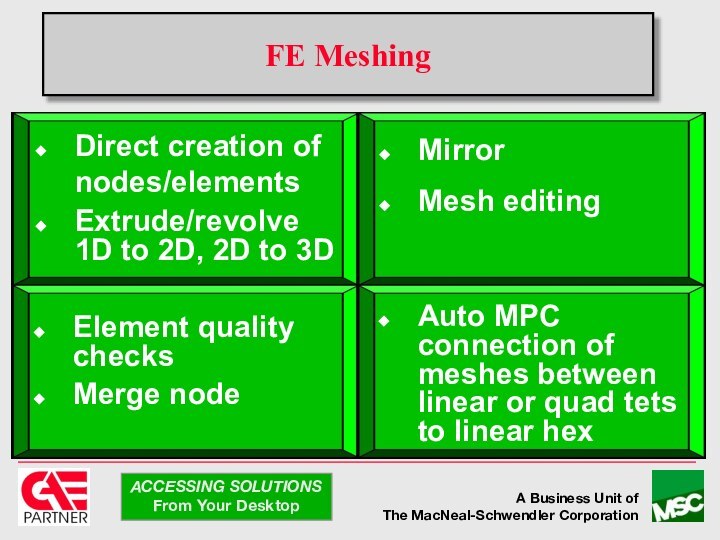

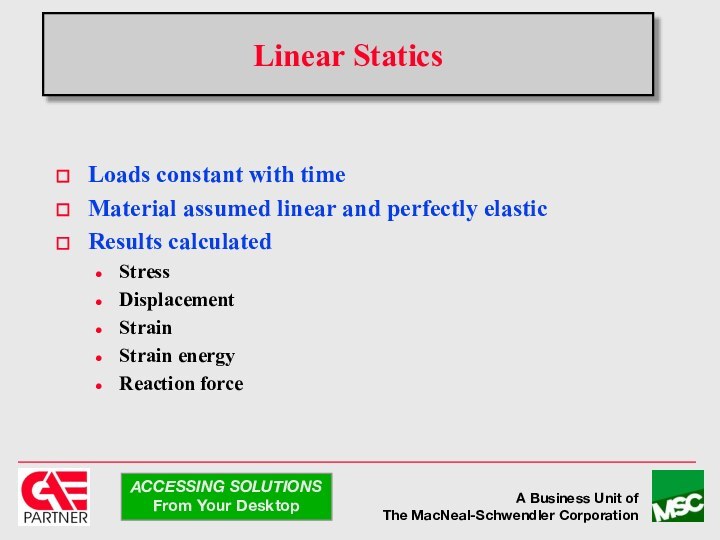
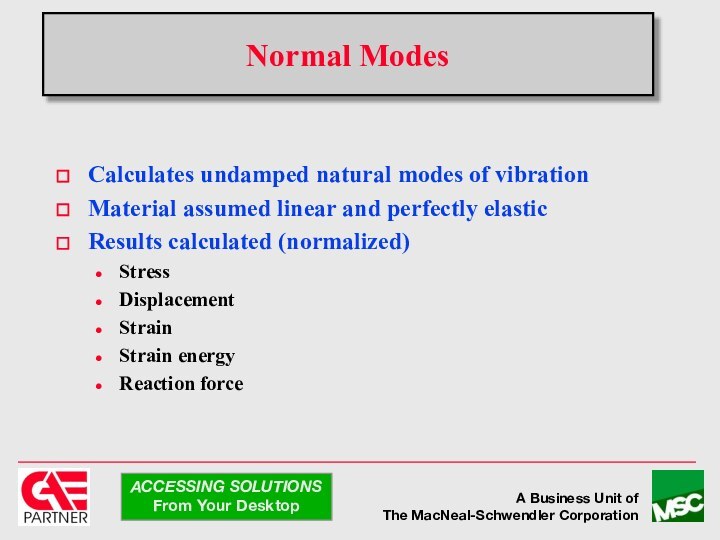
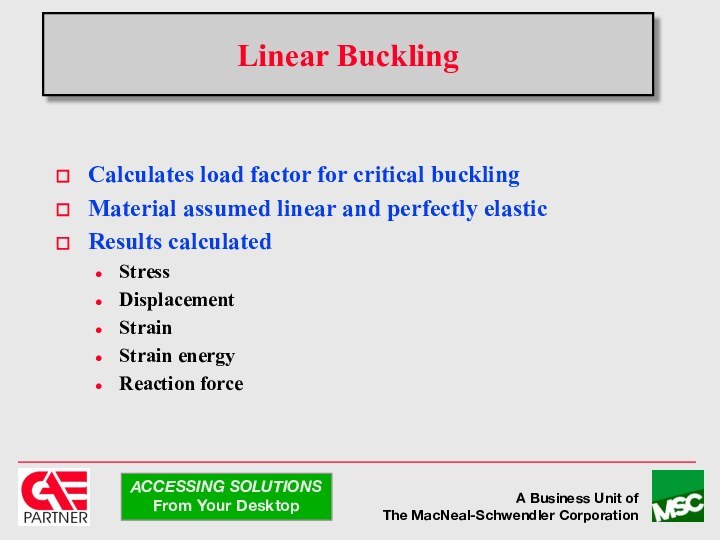
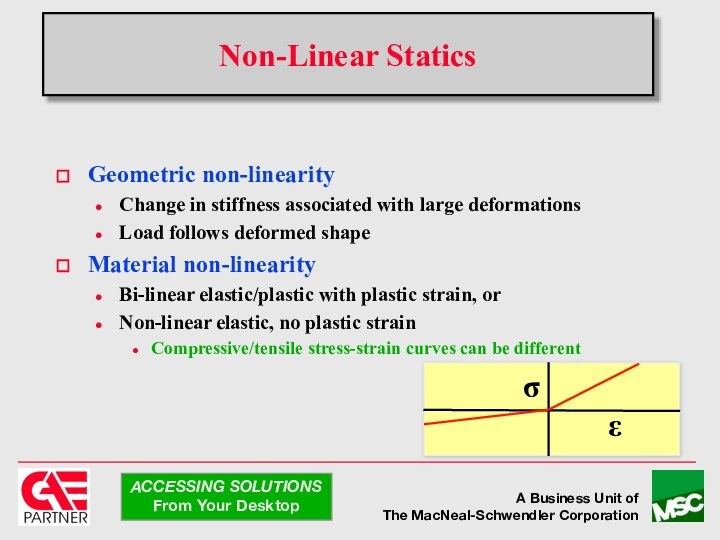
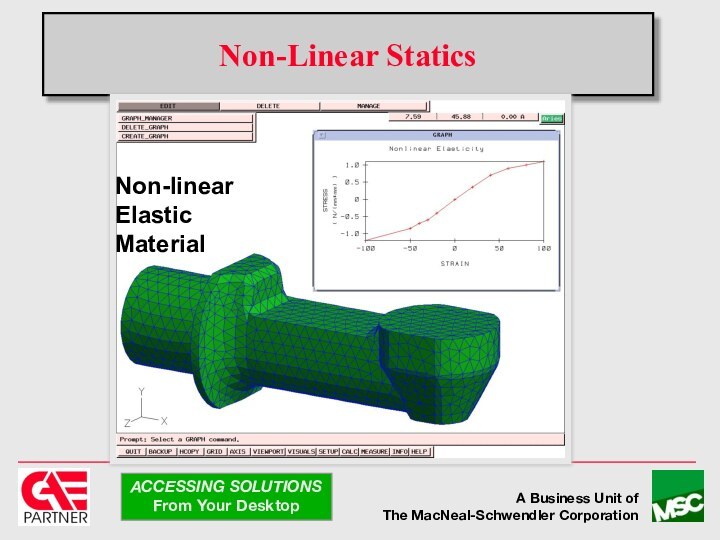
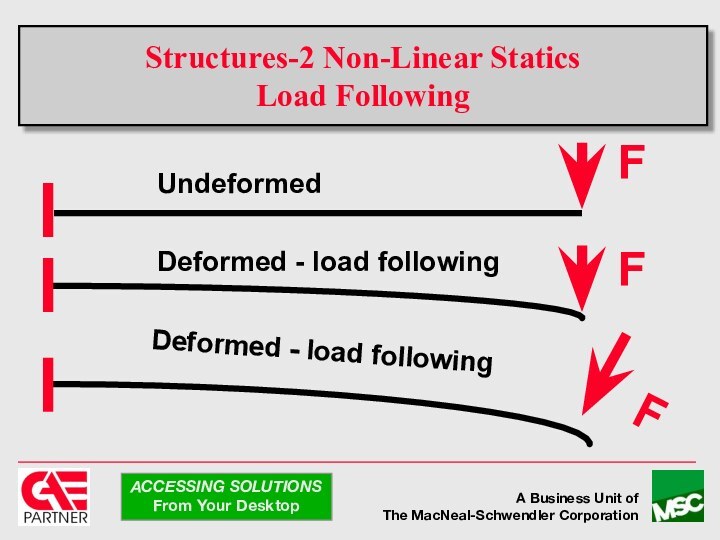
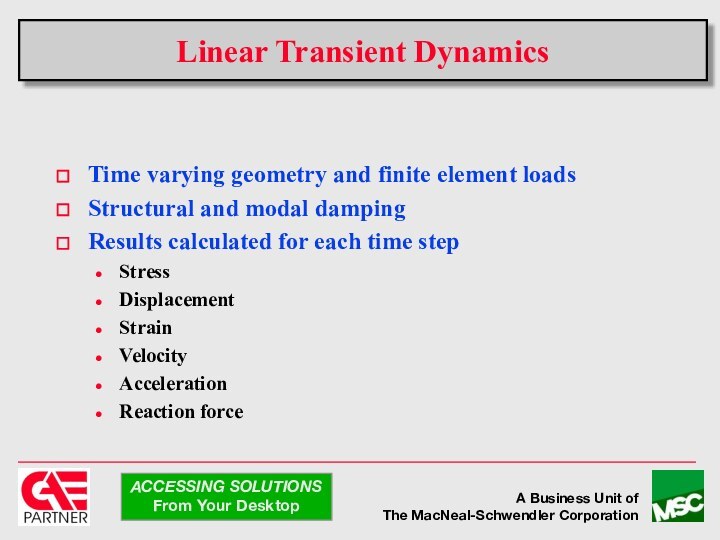
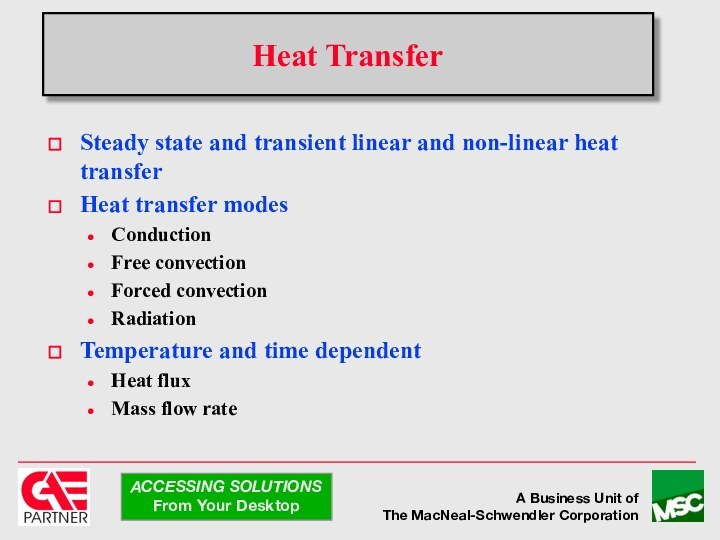
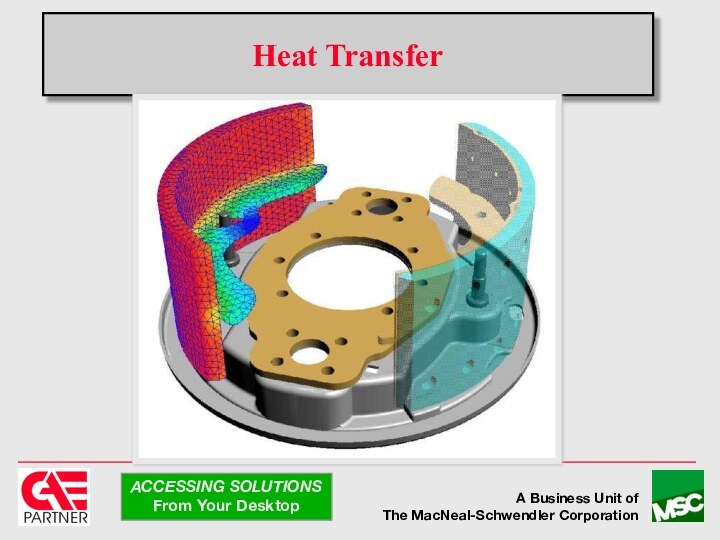

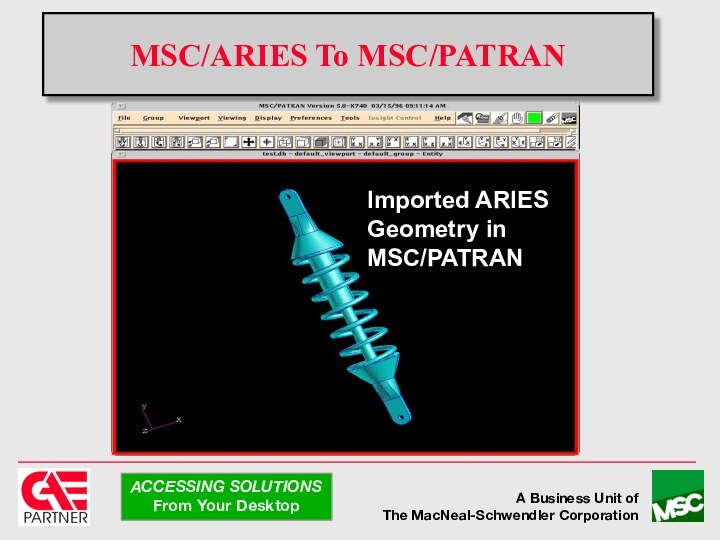
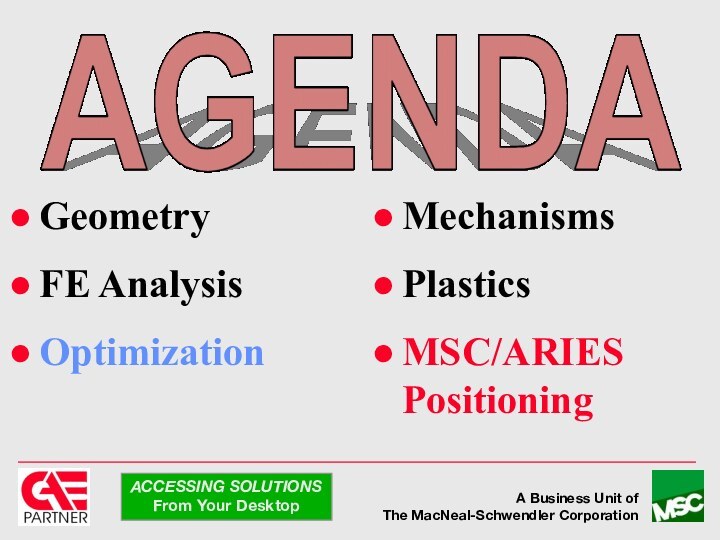
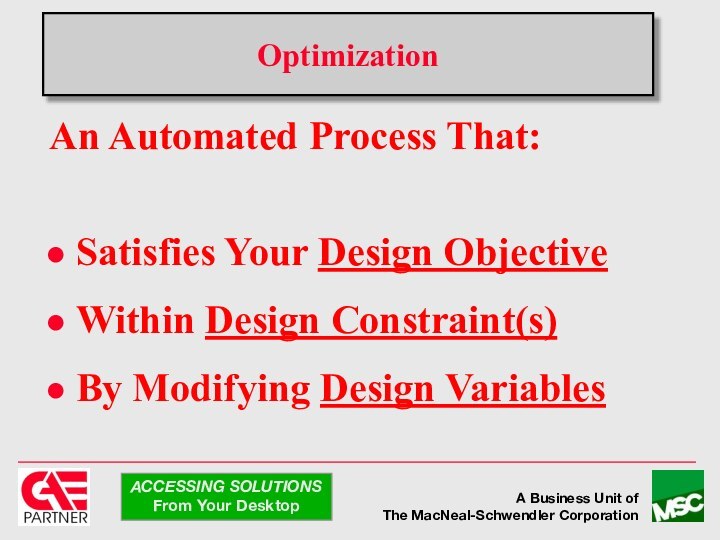
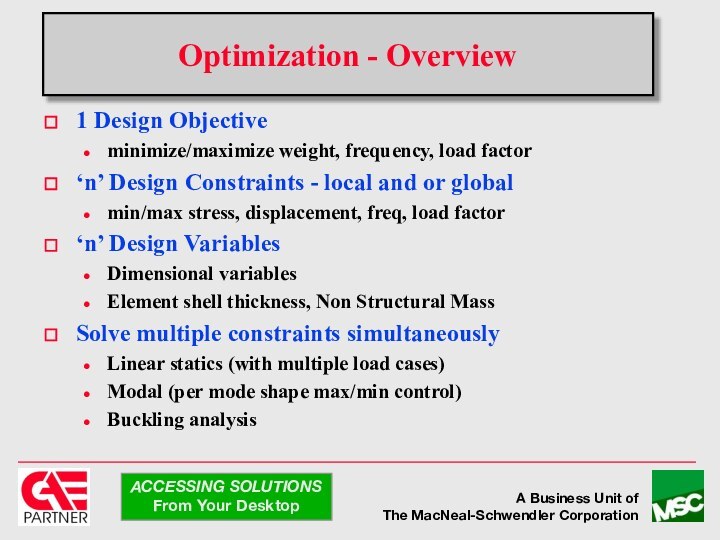
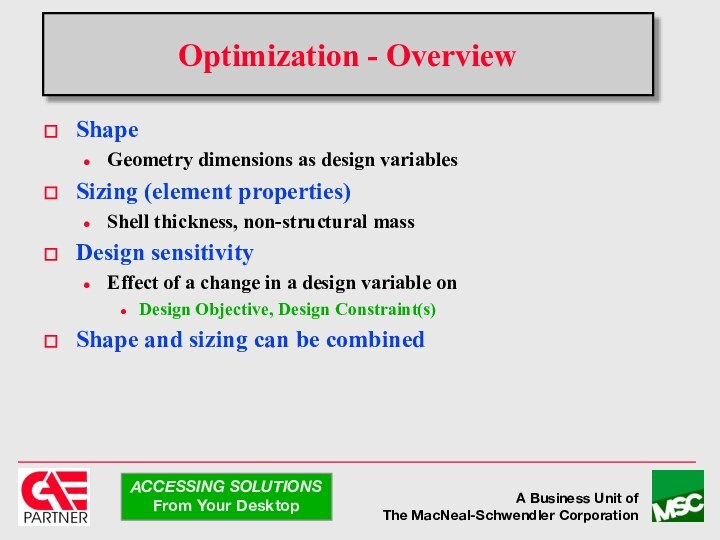
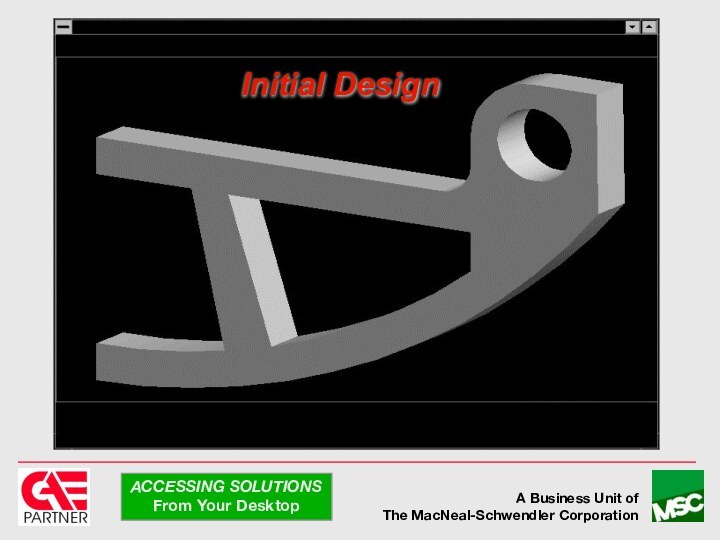

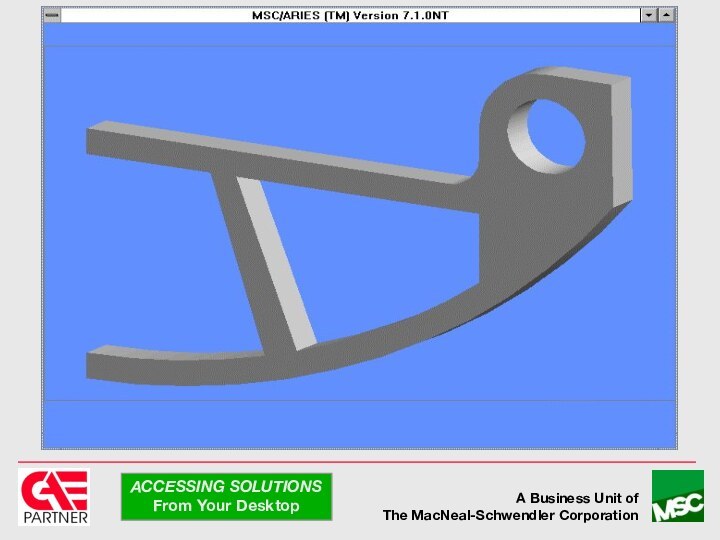
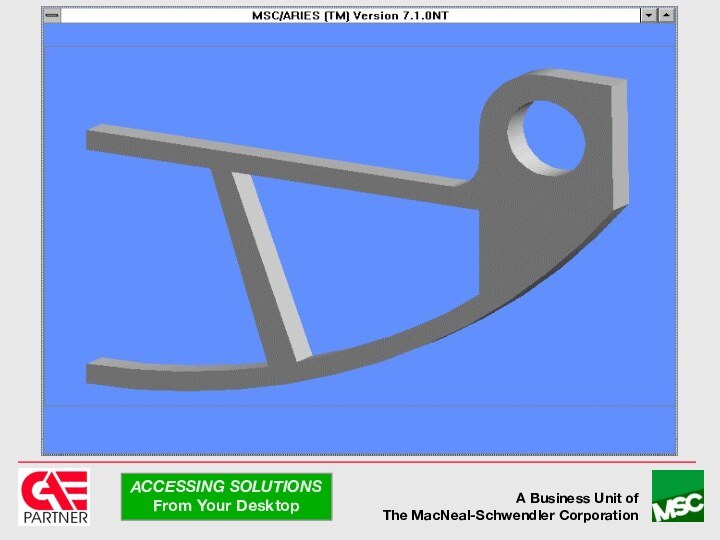
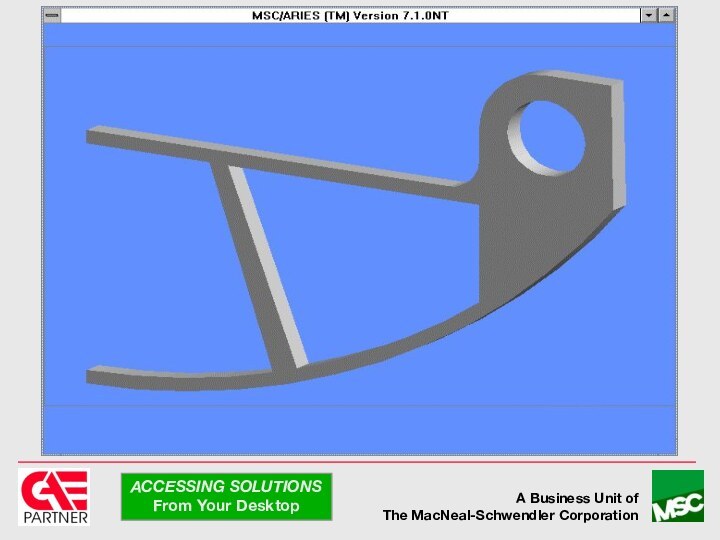
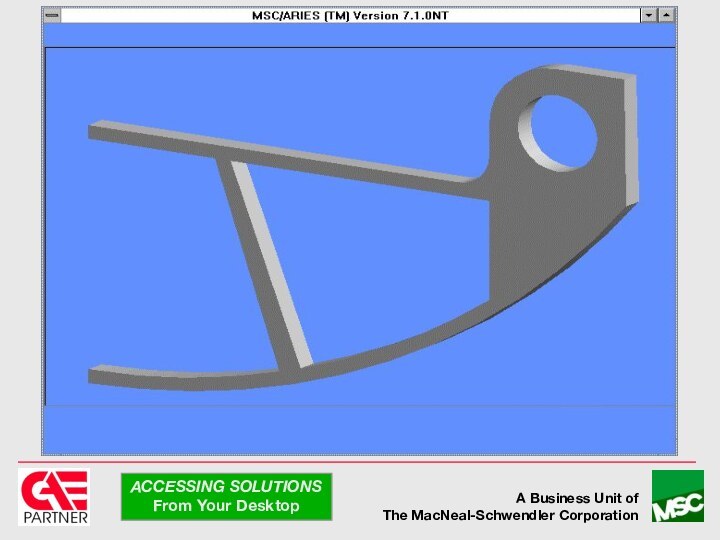
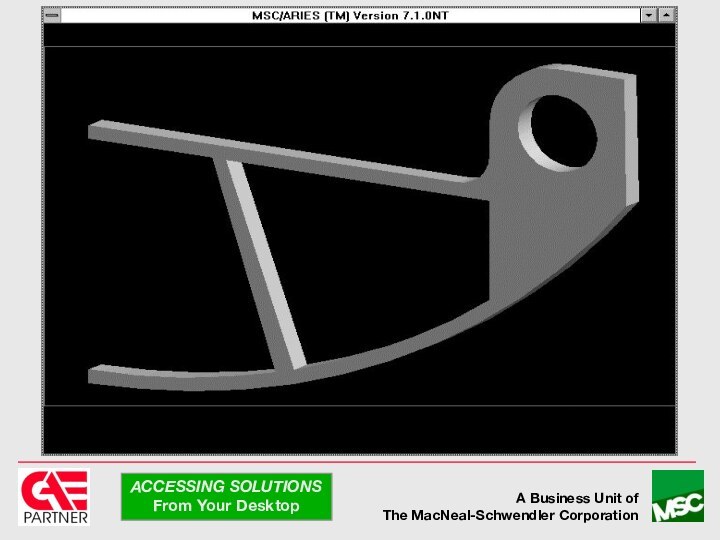
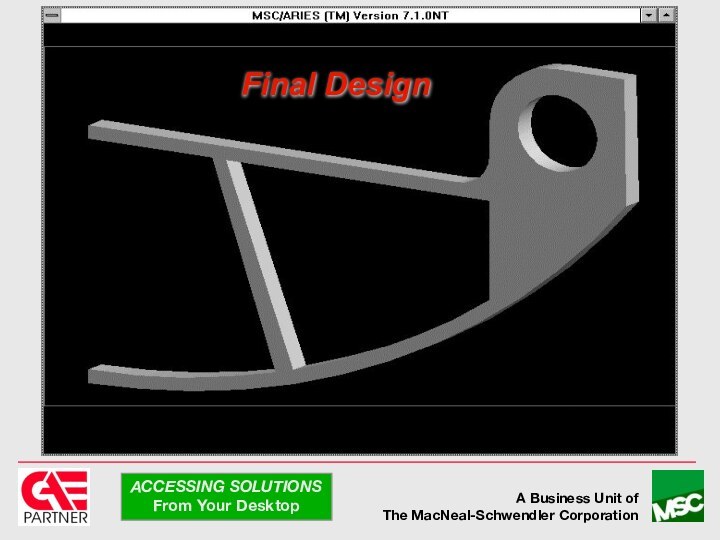
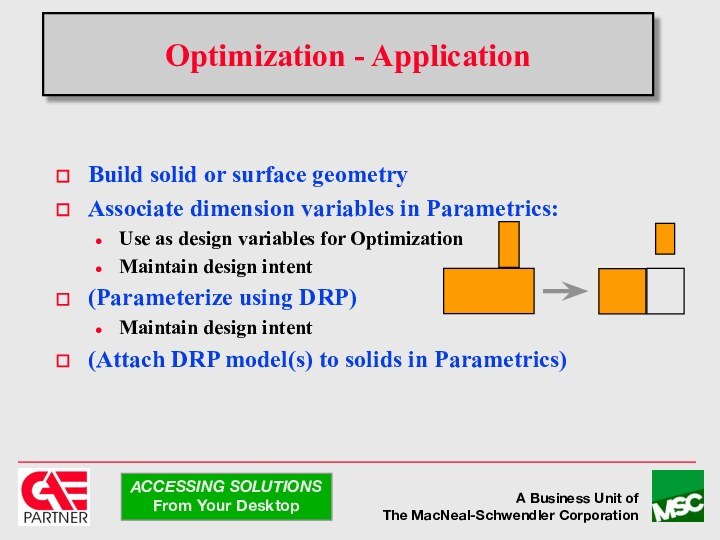
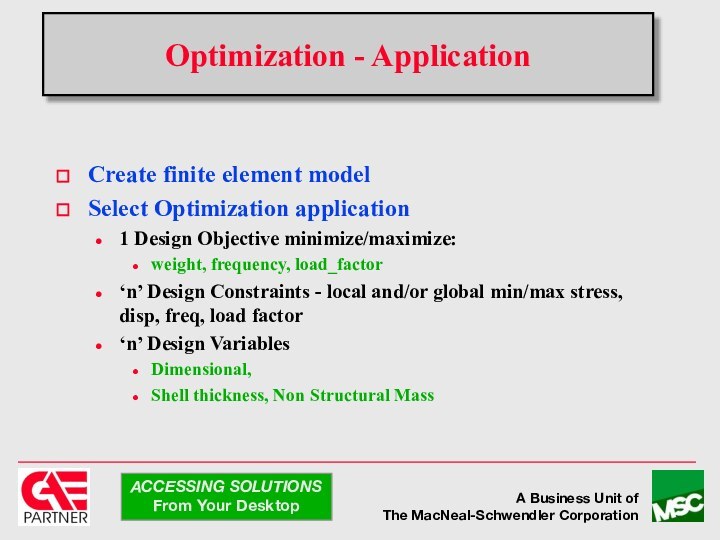
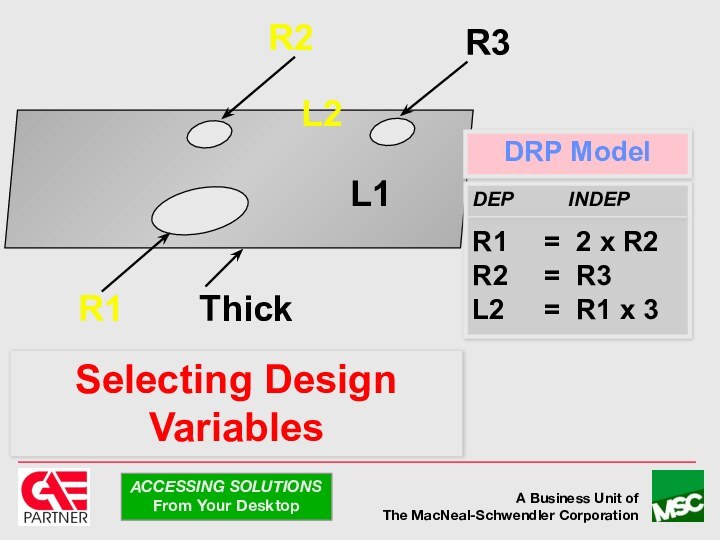
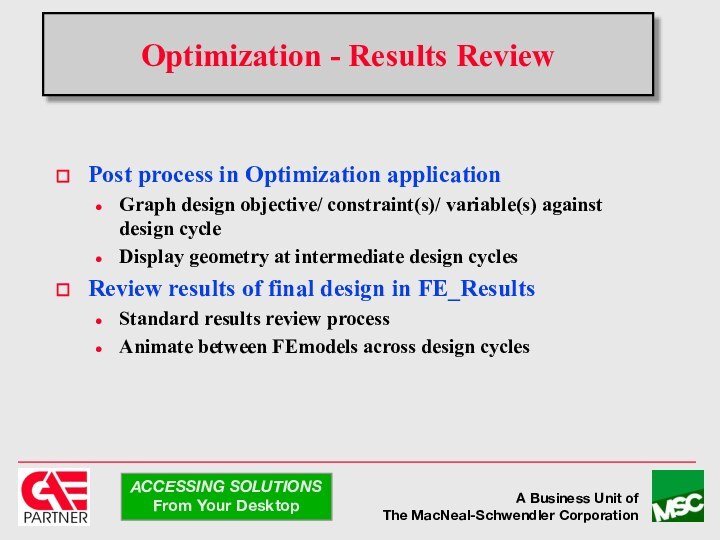
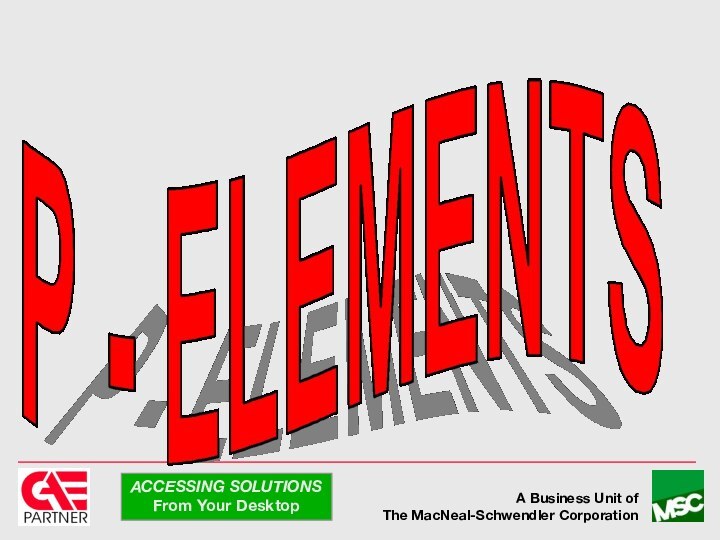

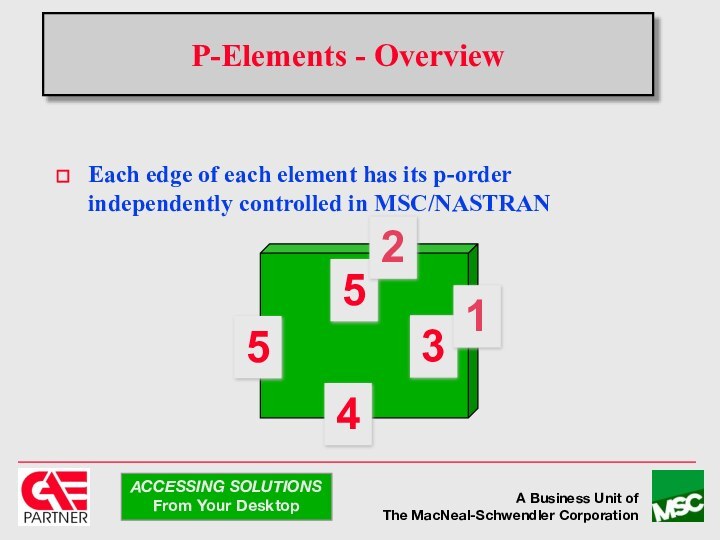
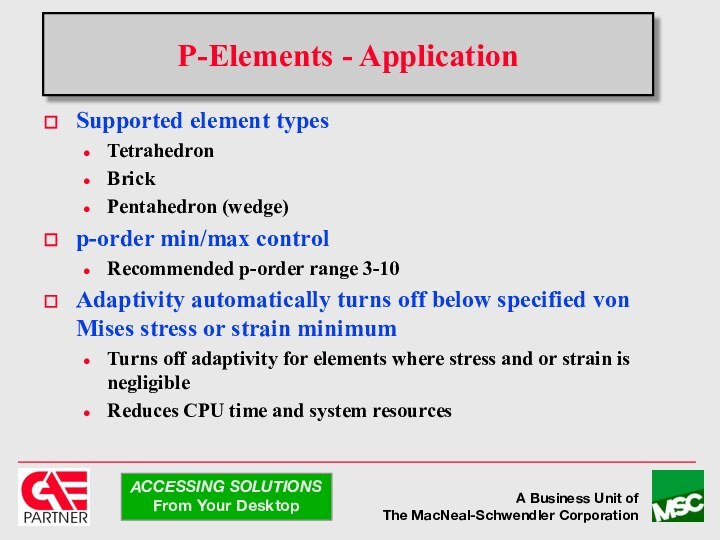
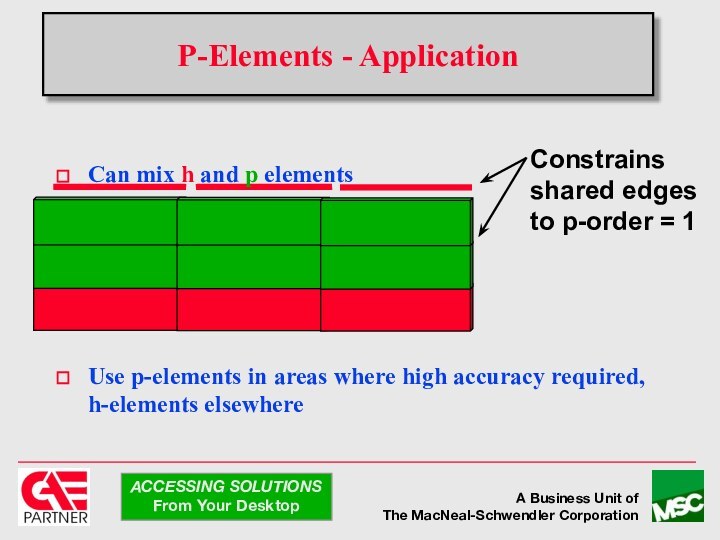
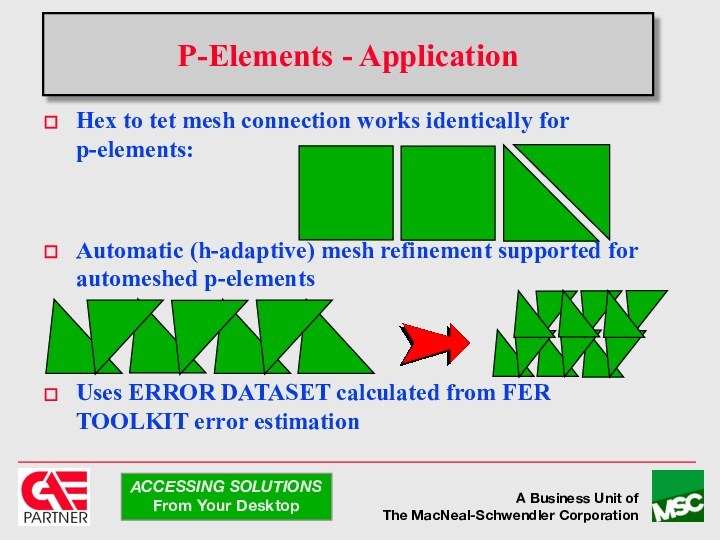
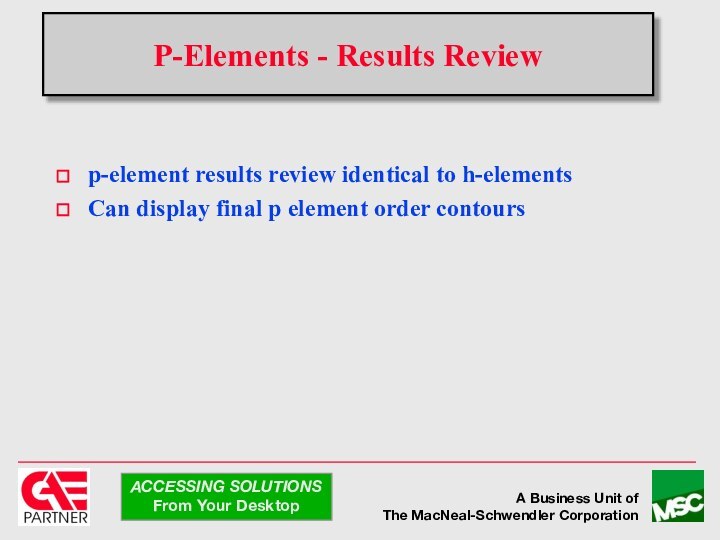
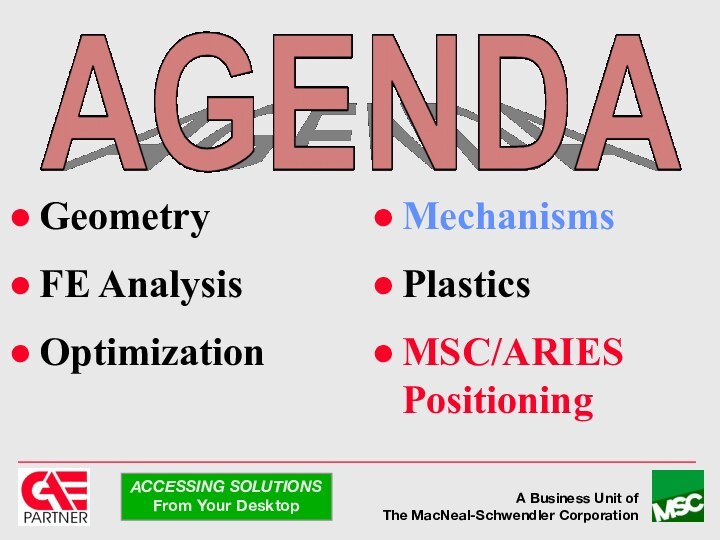
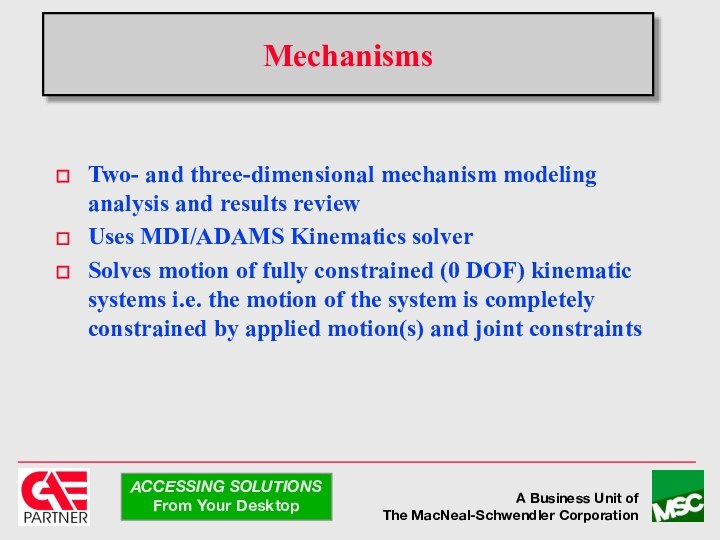
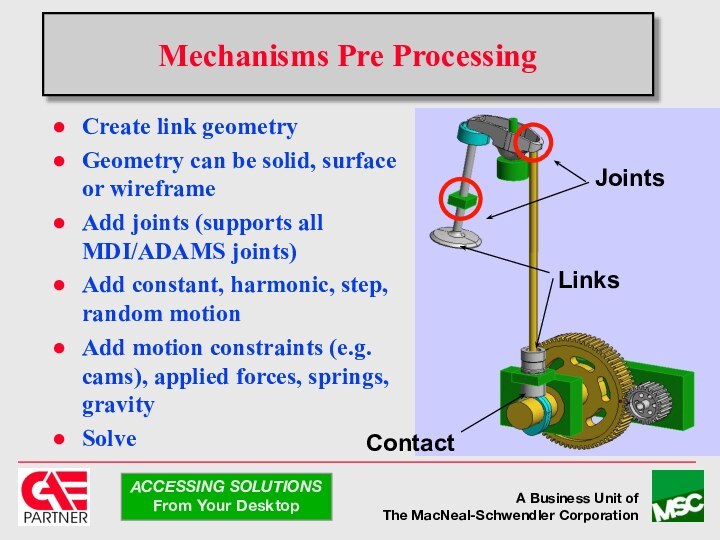
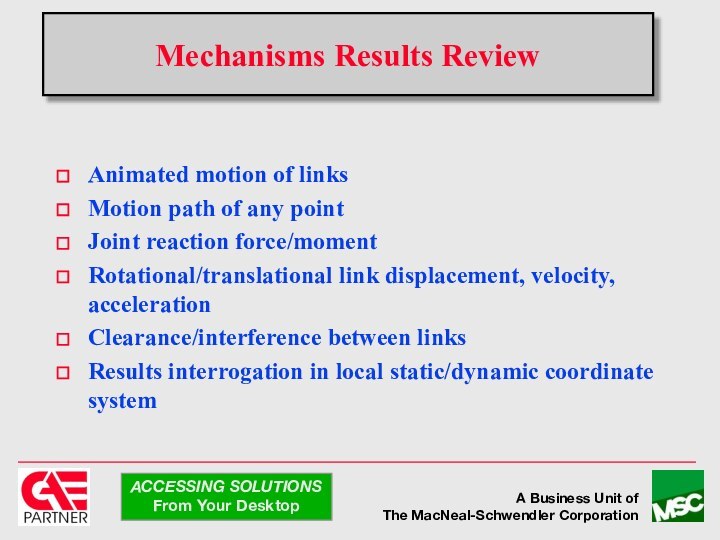
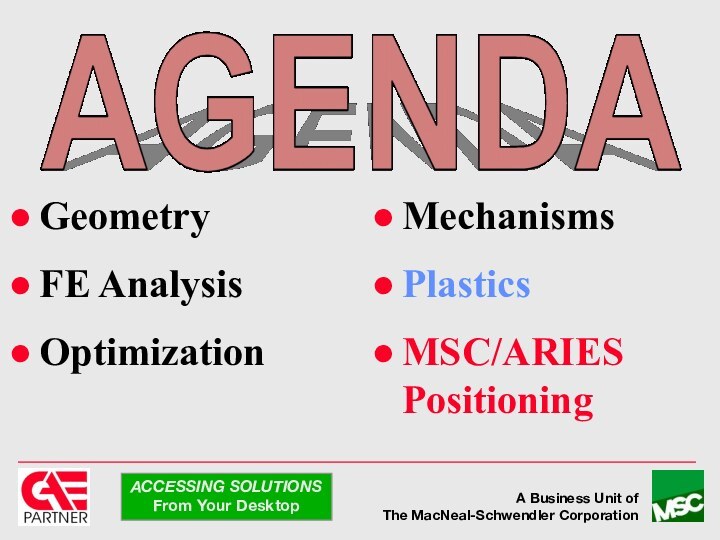
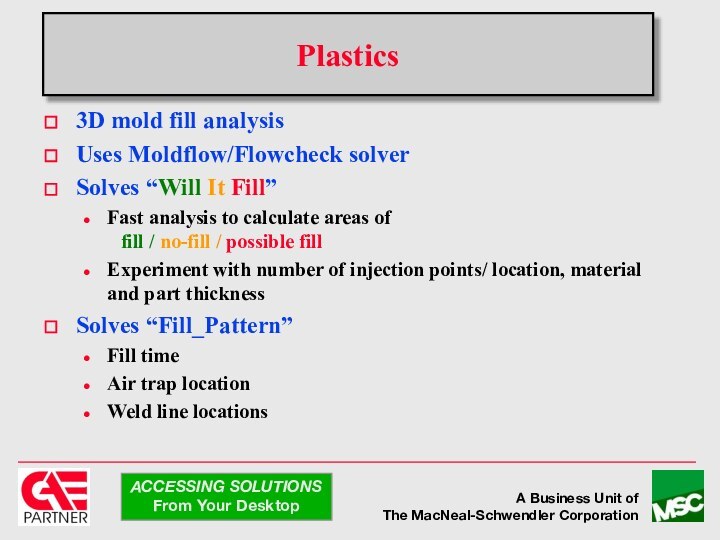
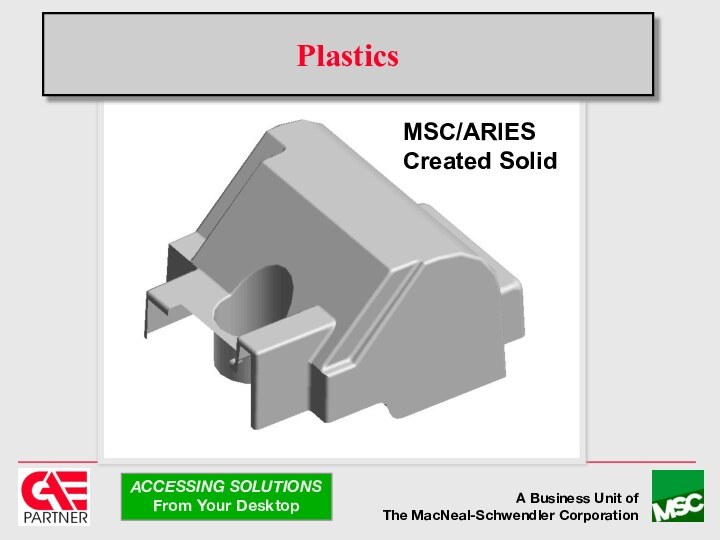
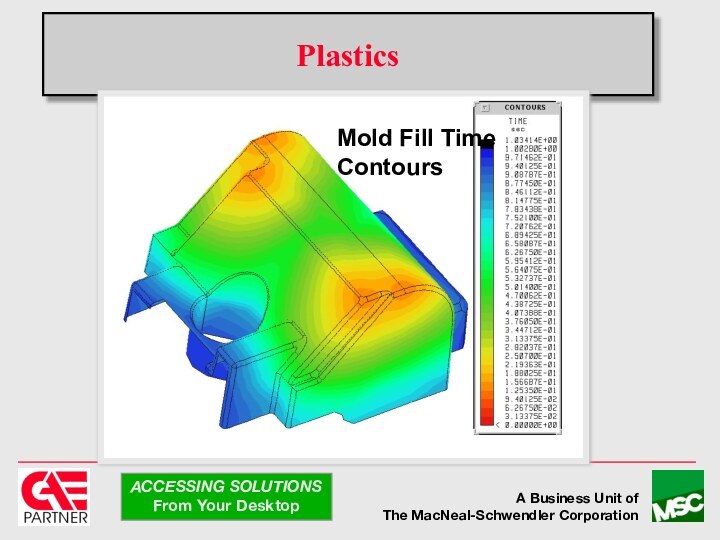

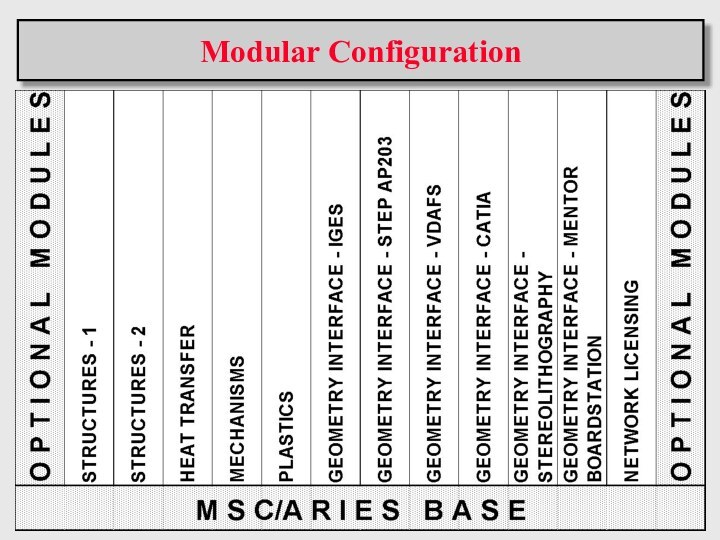
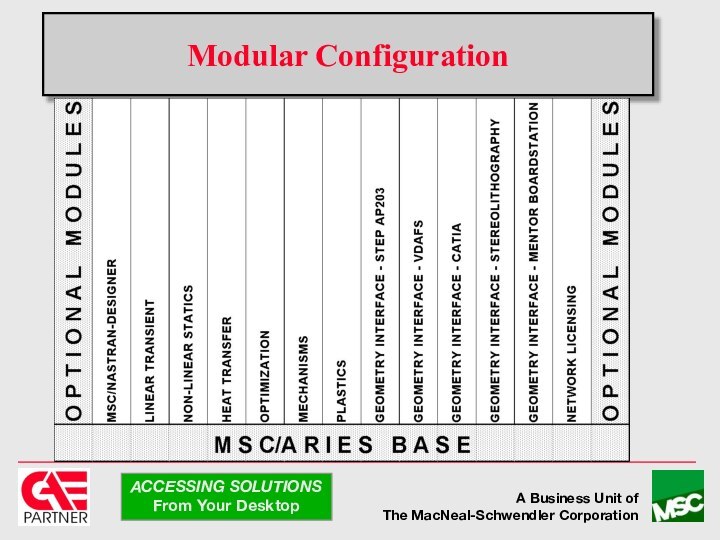
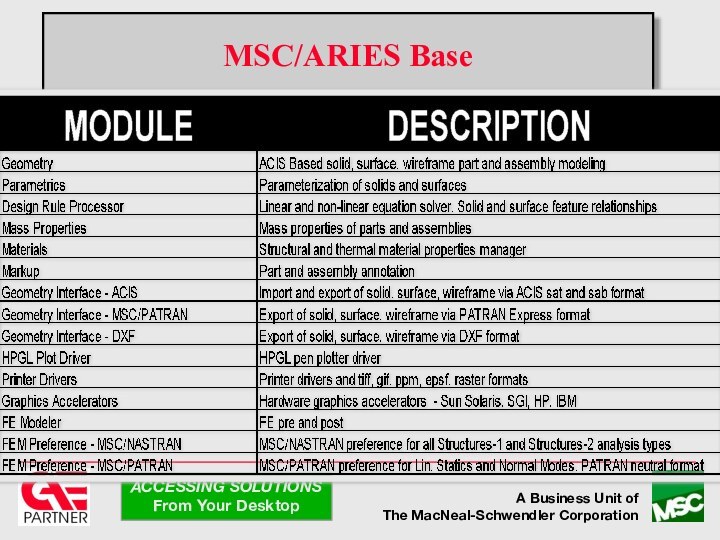
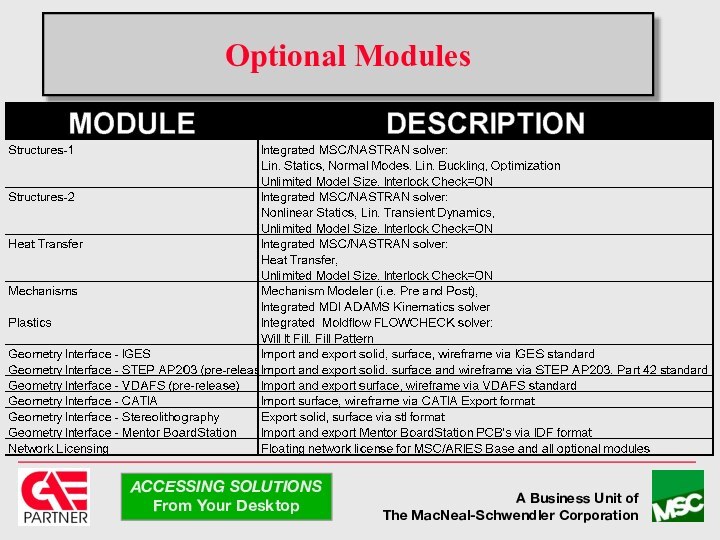

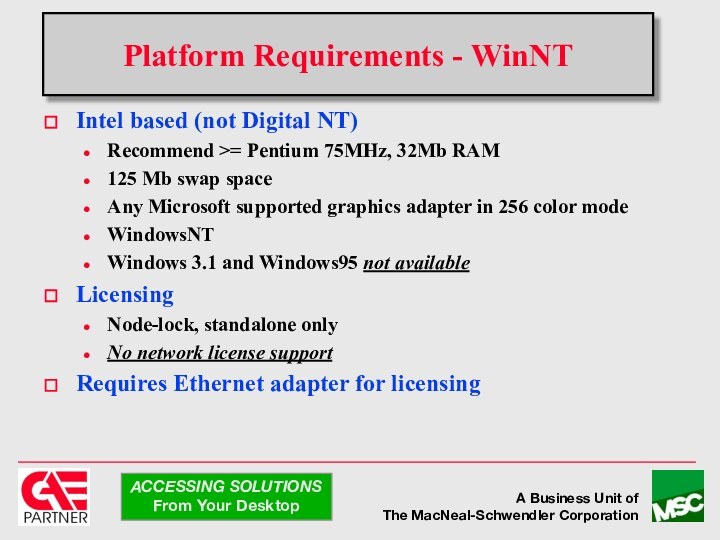
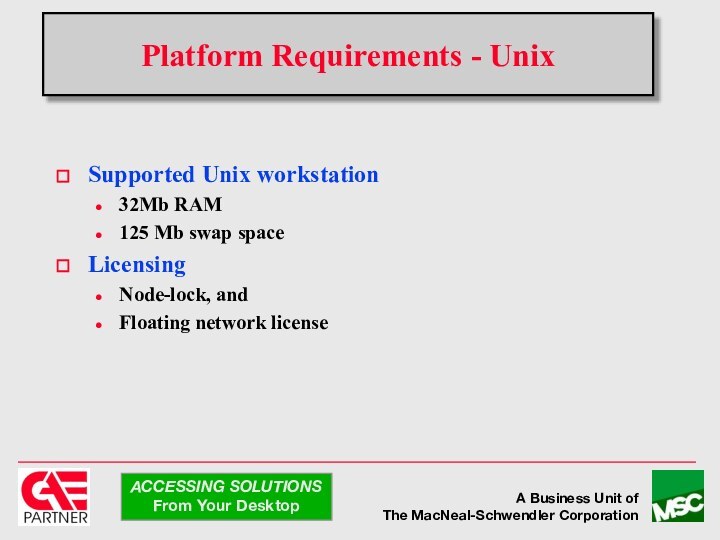
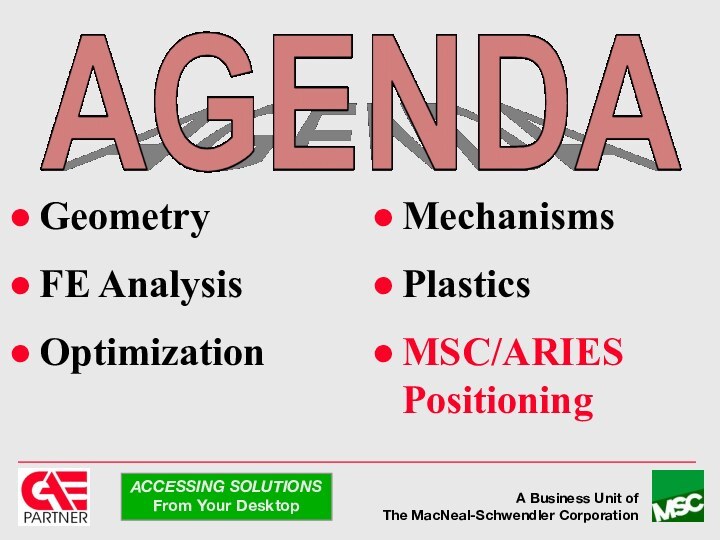
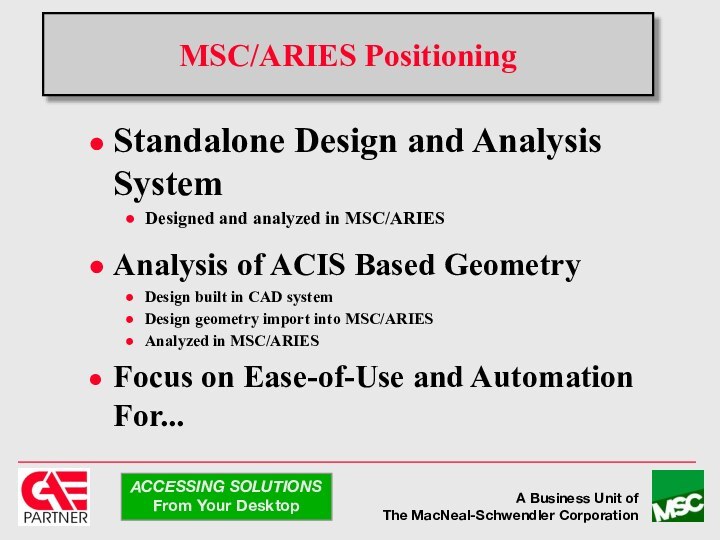
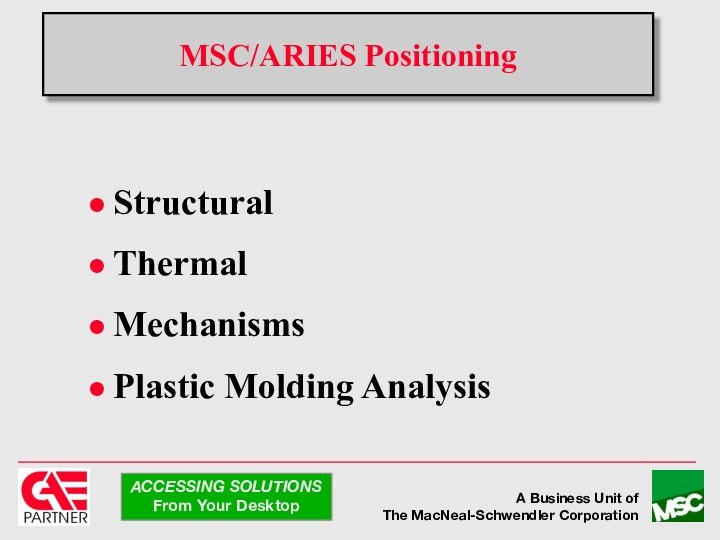

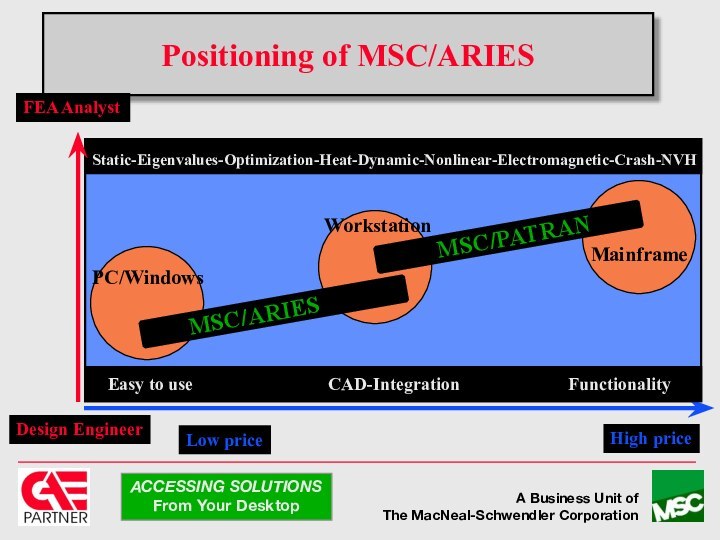
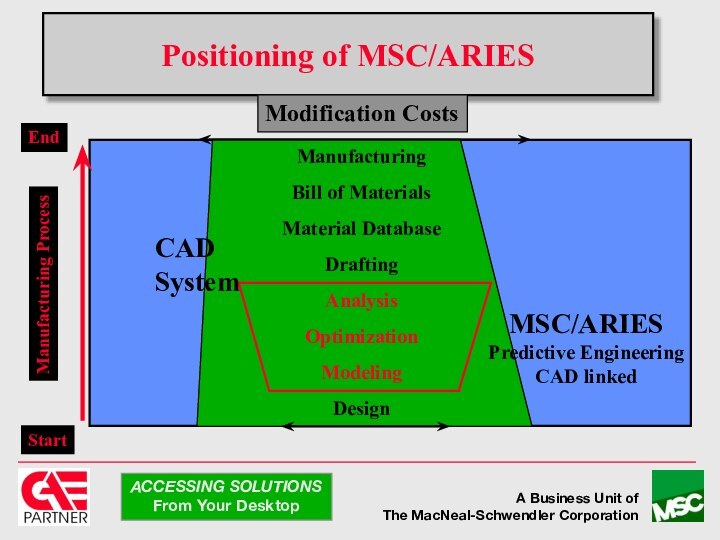
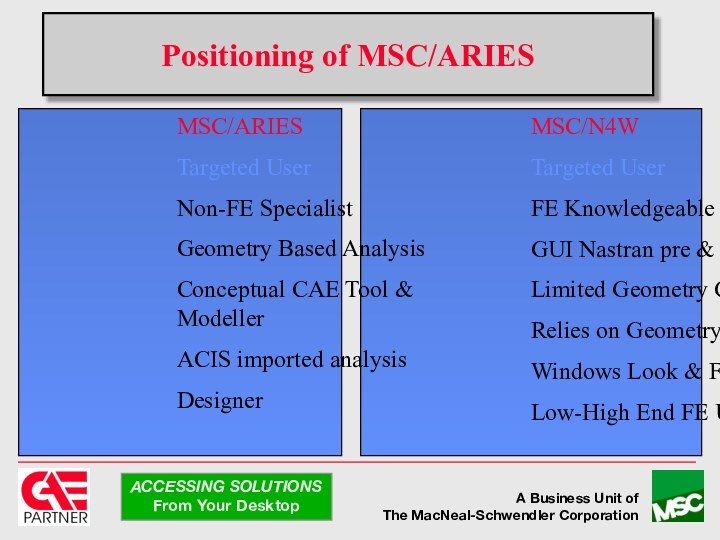
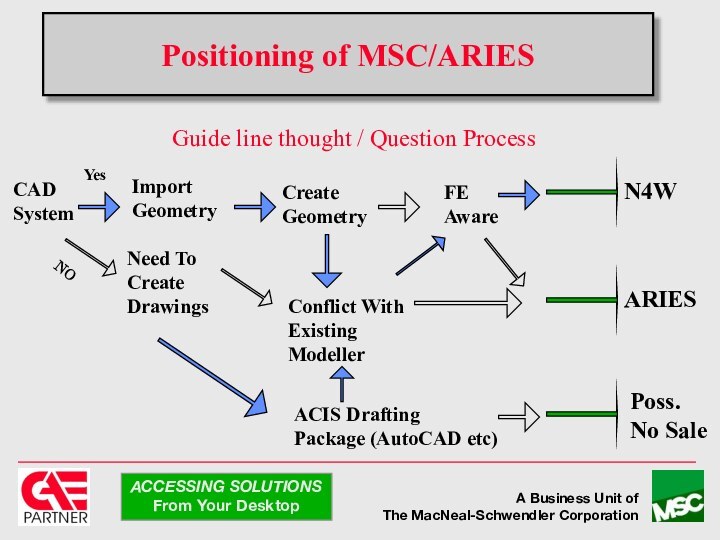

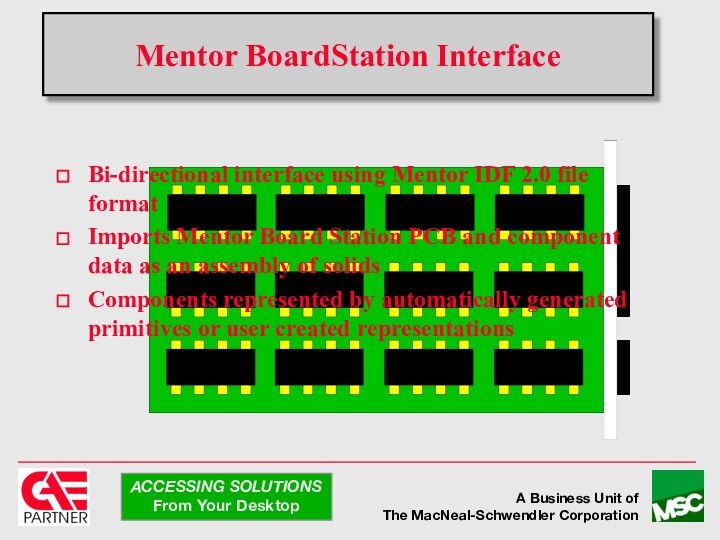
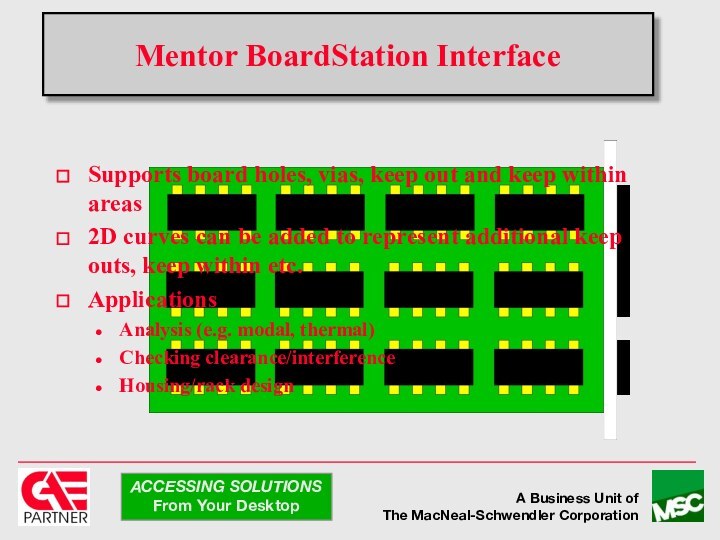
Слайд 8
Geometry
Complex solids
Skin operator
Sweep operator
Extensive blending and chamfering
Region operator
to sub-divide geometry
Map meshing
Load footprint areas
Symmetry
Слайд 15
Pre Release Solids Shelling
Shelling of solids to thin
walled solids
Per face (uniform) thickness control
Face exclusion to create
“open” solidsFull Parametrics support
Not supported
Spline faces (fillet, sweep, skin, spline segments in curve based primitives, extrude with draft
Слайд 17
Geometry Interface - ACIS
Support for ACIS sat (ASCII)
and sab (binary) file formats
Allows bi-directional exchange of solids,
surface and wireframeCurrently the most reliable solids data exchange format
Transfers geometry only
No feature or history information
Слайд 22
Geometry Interface - IGES Import
Supports
Wireframe
Point, line, arc,
composite curve, spline (112,126), conics (104), copious data (106)
Surface
Untrimmed
(118, 120, 122, 128)Trimmed (144)
Solid
Solid BREP (186, 514, 510, 508, 504, 502,)
Слайд 23
Geometry Interface - IGES Export
Supports
Wireframe
Point, line, arc,
composite curve, spline (112,126), conics (104)
Solid/surface
Decomposed to precise wireframe
BREP Decomposed to surface collection (trimmed or untrimmed - 128, 142, 144)
Text
Hidden line removal
Silhouette edge generation
Слайд 25
Geometry Interface - DXF Export
Supports
Wireframe
Point, line, arc,
composite curve, spline
Solid/surface
Decomposed to precise wireframe BREP
Text
Hidden line
removalSilhouette edge generation
Слайд 26
Geometry Interfaces - STEP, VDAFS
PDES/STEP AP203
Import and export
of solid/surface/wireframe data
VDAFS
Import and export of surface/wireframe data
Data format
that emphasizes surface transferUsed predominantly by European automotive industry
Слайд 27
Geometry Interfaces -Stereolithography
Translates solids into standard “stl” format
Rapid
manufacture for physical part prototyping
Слайд 29
LBC’s applied to geometry or to nodes &
elements
Supported loads
Force, moment, pressure
Gravity
Velocity
Translational
Rotational
Acceleration
Translational
Load and Boundary Conditions
Слайд 30
Constant or functional varying magnitude
Geometry based load
and boundary conditions survive geometry change
Load and Boundary Conditions
Слайд 31
Load and Boundary Conditions
Direction control for load/boundary conditions
XYZ
Radial
Tangential
Слайд 33
Automeshing technology
Edges -- 1D elements (beam, gap, rigid, spring)
Surfaces -- quad dominant
or all trias
Volumes -- tets only
Map meshing for surfaces and volumes
3/4
side surfaces, 5/6 face volumes Composite edge support
FE Meshing
Слайд 35
FE Meshing
Adaptive mesh refinement
Automatic mesh refinement to optimize
mesh density
Use with automatically generated h or p
meshesGlobal or local refinement
New mesh density based on current error versus target error
Reduces mesh density related errors
Слайд 37
FE Meshing
Direct creation of nodes/elements
Extrude/revolve 1D to 2D,
2D to 3D
Mirror
Mesh editing
Element quality checks
Merge node
Auto
MPC connection of meshes between linear or quad tets to linear hex
Слайд 38
Display options
Vector
Contour
Graph
Animation
Cutting plane
Results in any coordinate system
Data averaging
control
Results combination
Error calculation
Results Review
Слайд 39
Linear Statics
Loads constant with time
Material assumed linear and
perfectly elastic
Results calculated
Stress
Displacement
Strain
Strain energy
Reaction force
Слайд 40
Normal Modes
Calculates undamped natural modes of vibration
Material assumed
linear and perfectly elastic
Results calculated (normalized)
Stress
Displacement
Strain
Strain energy
Reaction force
Слайд 41
Linear Buckling
Calculates load factor for critical buckling
Material assumed
linear and perfectly elastic
Results calculated
Stress
Displacement
Strain
Strain energy
Reaction force
Слайд 42
Non-Linear Statics
Geometric non-linearity
Change in stiffness associated with large
deformations
Load follows deformed shape
Material non-linearity
Bi-linear elastic/plastic with plastic
strain, orNon-linear elastic, no plastic strain
Compressive/tensile stress-strain curves can be different
ε
σ
Слайд 44
Structures-2 Non-Linear Statics
Load Following
Deformed - load following
Deformed -
load following
F
F
F
Undeformed
Слайд 45
Linear Transient Dynamics
Time varying geometry and finite element
loads
Structural and modal damping
Results calculated for each time step
Stress
Displacement
Strain
Velocity
Acceleration
Reaction
force
Слайд 46
Heat Transfer
Steady state and transient linear and non-linear
heat transfer
Heat transfer modes
Conduction
Free convection
Forced convection
Radiation
Temperature and time dependent
Heat flux
Mass flow rate
Слайд 51
Optimization
An Automated Process That:
Satisfies Your Design Objective
Within
Design Constraint(s)
By Modifying Design Variables
Слайд 52
Optimization - Overview
1 Design Objective
minimize/maximize weight, frequency,
load factor
‘n’ Design Constraints - local and or global
min/max
stress, displacement, freq, load factor‘n’ Design Variables
Dimensional variables
Element shell thickness, Non Structural Mass
Solve multiple constraints simultaneously
Linear statics (with multiple load cases)
Modal (per mode shape max/min control)
Buckling analysis
Слайд 53
Optimization - Overview
Shape
Geometry dimensions as design variables
Sizing
(element properties)
Shell thickness, non-structural mass
Design sensitivity
Effect of a
change in a design variable onDesign Objective, Design Constraint(s)
Shape and sizing can be combined
Слайд 62
Optimization - Application
Build solid or surface geometry
Associate dimension
variables in Parametrics:
Use as design variables for Optimization
Maintain
design intent(Parameterize using DRP)
Maintain design intent
(Attach DRP model(s) to solids in Parametrics)
Слайд 63
Optimization - Application
Create finite element model
Select Optimization application
1
Design Objective minimize/maximize:
weight, frequency, load_factor
‘n’ Design Constraints - local
and/or global min/max stress, disp, freq, load factor‘n’ Design Variables
Dimensional,
Shell thickness, Non Structural Mass
Слайд 65
Optimization - Results Review
Post process in Optimization application
Graph
design objective/ constraint(s)/ variable(s) against design cycle
Display geometry at
intermediate design cyclesReview results of final design in FE_Results
Standard results review process
Animate between FEmodels across design cycles
Слайд 67
P-Elements - Overview
Automatically increases element’s shape function polynomial
order during solution until convergence
Convergence based on per element
strain energy difference between p-order changesMesh remains unchanged
Слайд 68
P-Elements - Overview
Each edge of each element has
its p-order independently controlled in MSC/NASTRAN
5
5
2
3
1
4
Слайд 69
P-Elements - Application
Supported element types
Tetrahedron
Brick
Pentahedron (wedge)
p-order min/max control
Recommended
p-order range 3-10
Adaptivity automatically turns off below specified von
Mises stress or strain minimumTurns off adaptivity for elements where stress and or strain is negligible
Reduces CPU time and system resources
Слайд 70
P-Elements - Application
Constrains shared edges to p-order
= 1
Can mix h and p elements
Use p-elements in
areas where high accuracy required, h-elements elsewhere
Слайд 71
P-Elements - Application
Hex to tet mesh connection works
identically for p-elements:
Automatic (h-adaptive) mesh refinement supported for
automeshed p-elementsUses ERROR DATASET calculated from FER TOOLKIT error estimation
Слайд 72
P-Elements - Results Review
p-element results review identical to
h-elements
Can display final p element order contours
Слайд 74
Two- and three-dimensional mechanism modeling analysis and results
review
Uses MDI/ADAMS Kinematics solver
Solves motion of fully constrained
(0 DOF) kinematic systems i.e. the motion of the system is completely constrained by applied motion(s) and joint constraints Mechanisms
Слайд 75
Create link geometry
Geometry can be solid, surface or
wireframe
Add joints (supports all MDI/ADAMS joints)
Add constant, harmonic, step,
random motionAdd motion constraints (e.g. cams), applied forces, springs, gravity
Solve
Mechanisms Pre Processing
Links
Joints
Contact
Слайд 76
Mechanisms Results Review
Animated motion of links
Motion path of
any point
Joint reaction force/moment
Rotational/translational link displacement, velocity, acceleration
Clearance/interference between
linksResults interrogation in local static/dynamic coordinate system
Слайд 78
Plastics
3D mold fill analysis
Uses Moldflow/Flowcheck solver
Solves “Will It
Fill”
Fast analysis to calculate areas of
fill / no-fill /
possible fillExperiment with number of injection points/ location, material and part thickness
Solves “Fill_Pattern”
Fill time
Air trap location
Weld line locations
Слайд 87
Intel based (not Digital NT)
Recommend >= Pentium 75MHz,
32Mb RAM
125 Mb swap space
Any Microsoft supported graphics adapter
in 256 color modeWindowsNT
Windows 3.1 and Windows95 not available
Licensing
Node-lock, standalone only
No network license support
Requires Ethernet adapter for licensing
Platform Requirements - WinNT
Слайд 88
Supported Unix workstation
32Mb RAM
125 Mb swap space
Licensing
Node-lock, and
Floating
network license
Platform Requirements - Unix
Слайд 90
MSC/ARIES Positioning
Standalone Design and Analysis System
Designed and analyzed
in MSC/ARIES
Analysis of ACIS Based Geometry
Design built in CAD
systemDesign geometry import into MSC/ARIES
Analyzed in MSC/ARIES
Focus on Ease-of-Use and Automation For...
Слайд 93
Positioning of MSC/ARIES
FEA Analyst
Design Engineer
Low price
High price
Static-Eigenvalues-Optimization-Heat-Dynamic-Nonlinear-Electromagnetic-Crash-NVH
Easy to
use
CAD-Integration FunctionalityMSC/ARIES
MSC/PATRAN
PC/Windows
Workstation
Mainframe
Слайд 94
Positioning of MSC/ARIES
End
Start
Manufacturing Process
Manufacturing
Bill of Materials
Material Database
Drafting
Analysis
Optimization
Modeling
Design
MSC/ARIES
Predictive Engineering
CAD
linked
CAD
System
Modification Costs
Слайд 95
Positioning of MSC/ARIES
MSC/ARIES
Targeted User
Non-FE Specialist
Geometry Based Analysis
Conceptual CAE
Tool & Modeller
ACIS imported analysis
Designer
MSC/N4W
Targeted User
FE Knowledgeable
GUI Nastran
pre & postLimited Geometry Creation
Relies on Geometry Import
Windows Look & Feel
Low-High End FE User
Слайд 96
Positioning of MSC/ARIES
Guide line thought / Question Process
CAD
System
Import
Geometry
Create
Geometry
FE
Aware
N4W
ARIES
Poss.
No Sale
Conflict With
Existing
Modeller
Need To
Create
Drawings
ACIS Drafting
Package (AutoCAD etc)
NO
Yes
Слайд 98
Mentor BoardStation Interface
Bi-directional interface using Mentor IDF 2.0
file format
Imports Mentor Board Station PCB and component data
as an assembly of solidsComponents represented by automatically generated primitives or user created representations












